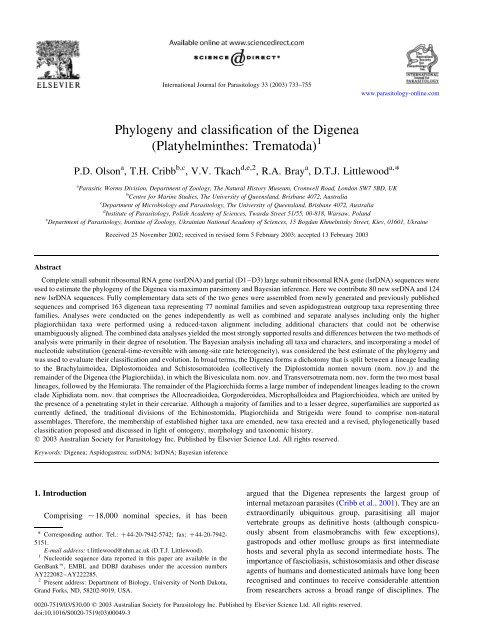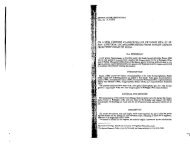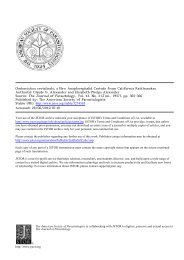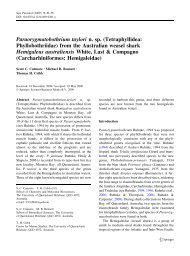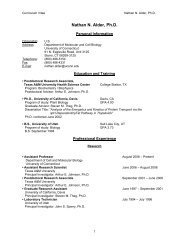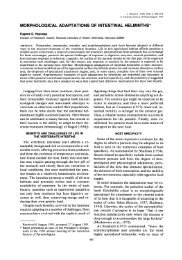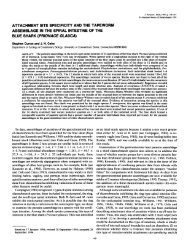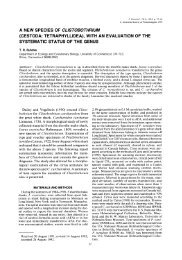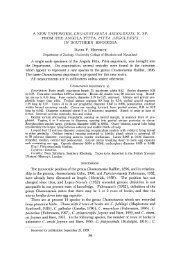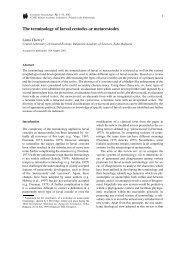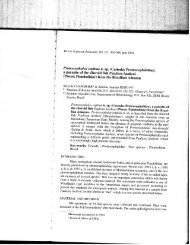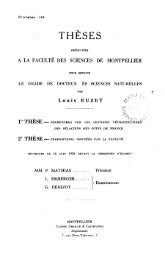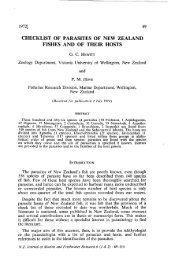Phylogeny and classification of the Digenea (Platyhelminthes ...
Phylogeny and classification of the Digenea (Platyhelminthes ...
Phylogeny and classification of the Digenea (Platyhelminthes ...
Create successful ePaper yourself
Turn your PDF publications into a flip-book with our unique Google optimized e-Paper software.
International Journal for Parasitology 33 (2003) 733–755www.parasitology-online.com<strong>Phylogeny</strong> <strong>and</strong> <strong>classification</strong> <strong>of</strong> <strong>the</strong> <strong>Digenea</strong>(Platyhelmin<strong>the</strong>s: Trematoda) 1P.D. Olson a , T.H. Cribb b,c , V.V. Tkach d,e,2 , R.A. Bray a , D.T.J. Littlewood a, *a Parasitic Worms Division, Department <strong>of</strong> Zoology, The Natural History Museum, Cromwell Road, London SW7 5BD, UKb Centre for Marine Studies, The University <strong>of</strong> Queensl<strong>and</strong>, Brisbane 4072, Australiac Department <strong>of</strong> Microbiology <strong>and</strong> Parasitology, The University <strong>of</strong> Queensl<strong>and</strong>, Brisbane 4072, Australiad Institute <strong>of</strong> Parasitology, Polish Academy <strong>of</strong> Sciences, Twarda Street 51/55, 00-818, Warsaw, Pol<strong>and</strong>e Department <strong>of</strong> Parasitology, Institute <strong>of</strong> Zoology, Ukrainian National Academy <strong>of</strong> Sciences, 15 Bogdan Khmelnitsky Street, Kiev, 01601, UkraineReceived 25 November 2002; received in revised form 5 February 2003; accepted 13 February 2003AbstractComplete small subunit ribosomal RNA gene (ssrDNA) <strong>and</strong> partial (D1–D3) large subunit ribosomal RNA gene (lsrDNA) sequences wereused to estimate <strong>the</strong> phylogeny <strong>of</strong> <strong>the</strong> <strong>Digenea</strong> via maximum parsimony <strong>and</strong> Bayesian inference. Here we contribute 80 new ssrDNA <strong>and</strong> 124new lsrDNA sequences. Fully complementary data sets <strong>of</strong> <strong>the</strong> two genes were assembled from newly generated <strong>and</strong> previously publishedsequences <strong>and</strong> comprised 163 digenean taxa representing 77 nominal families <strong>and</strong> seven aspidogastrean outgroup taxa representing threefamilies. Analyses were conducted on <strong>the</strong> genes independently as well as combined <strong>and</strong> separate analyses including only <strong>the</strong> higherplagiorchiidan taxa were performed using a reduced-taxon alignment including additional characters that could not be o<strong>the</strong>rwiseunambiguously aligned. The combined data analyses yielded <strong>the</strong> most strongly supported results <strong>and</strong> differences between <strong>the</strong> two methods <strong>of</strong>analysis were primarily in <strong>the</strong>ir degree <strong>of</strong> resolution. The Bayesian analysis including all taxa <strong>and</strong> characters, <strong>and</strong> incorporating a model <strong>of</strong>nucleotide substitution (general-time-reversible with among-site rate heterogeneity), was considered <strong>the</strong> best estimate <strong>of</strong> <strong>the</strong> phylogeny <strong>and</strong>was used to evaluate <strong>the</strong>ir <strong>classification</strong> <strong>and</strong> evolution. In broad terms, <strong>the</strong> <strong>Digenea</strong> forms a dichotomy that is split between a lineage leadingto <strong>the</strong> Brachylaimoidea, Diplostomoidea <strong>and</strong> Schistosomatoidea (collectively <strong>the</strong> Diplostomida nomen novum (nom. nov.)) <strong>and</strong> <strong>the</strong>remainder <strong>of</strong> <strong>the</strong> <strong>Digenea</strong> (<strong>the</strong> Plagiorchiida), in which <strong>the</strong> Bivesiculata nom. nov. <strong>and</strong> Transversotremata nom. nov. form <strong>the</strong> two most basallineages, followed by <strong>the</strong> Hemiurata. The remainder <strong>of</strong> <strong>the</strong> Plagiorchiida forms a large number <strong>of</strong> independent lineages leading to <strong>the</strong> crownclade Xiphidiata nom. nov. that comprises <strong>the</strong> Allocreadioidea, Gorgoderoidea, Microphalloidea <strong>and</strong> Plagiorchioidea, which are united by<strong>the</strong> presence <strong>of</strong> a penetrating stylet in <strong>the</strong>ir cercariae. Although a majority <strong>of</strong> families <strong>and</strong> to a lesser degree, superfamilies are supported ascurrently defined, <strong>the</strong> traditional divisions <strong>of</strong> <strong>the</strong> Echinostomida, Plagiorchiida <strong>and</strong> Strigeida were found to comprise non-naturalassemblages. Therefore, <strong>the</strong> membership <strong>of</strong> established higher taxa are emended, new taxa erected <strong>and</strong> a revised, phylogenetically based<strong>classification</strong> proposed <strong>and</strong> discussed in light <strong>of</strong> ontogeny, morphology <strong>and</strong> taxonomic history.q 2003 Australian Society for Parasitology Inc. Published by Elsevier Science Ltd. All rights reserved.Keywords: <strong>Digenea</strong>; Aspidogastrea; ssrDNA; lsrDNA; Bayesian inference1. IntroductionComprising ,18,000 nominal species, it has been* Corresponding author. Tel.: þ44-20-7942-5742; fax: þ44-20-7942-5151.E-mail address: t.littlewood@nhm.ac.uk (D.T.J. Littlewood).1 Nucleotide sequence data reported in this paper are available in <strong>the</strong>GenBanke, EMBL <strong>and</strong> DDBJ databases under <strong>the</strong> accession numbersAY222082–AY222285.2 Present address: Department <strong>of</strong> Biology, University <strong>of</strong> North Dakota,Gr<strong>and</strong> Forks, ND, 58202-9019, USA.argued that <strong>the</strong> <strong>Digenea</strong> represents <strong>the</strong> largest group <strong>of</strong>internal metazoan parasites (Cribb et al., 2001). They are anextraordinarily ubiquitous group, parasitising all majorvertebrate groups as definitive hosts (although conspicuouslyabsent from elasmobranchs with few exceptions),gastropods <strong>and</strong> o<strong>the</strong>r mollusc groups as first intermediatehosts <strong>and</strong> several phyla as second intermediate hosts. Theimportance <strong>of</strong> fascioliasis, schistosomiasis <strong>and</strong> o<strong>the</strong>r diseaseagents <strong>of</strong> humans <strong>and</strong> domesticated animals have long beenrecognised <strong>and</strong> continues to receive considerable attentionfrom researchers across a broad range <strong>of</strong> disciplines. The0020-7519/03/$30.00 q 2003 Australian Society for Parasitology Inc. Published by Elsevier Science Ltd. All rights reserved.doi:10.1016/S0020-7519(03)00049-3
734P.D. Olson et al. / International Journal for Parasitology 33 (2003) 733–755underst<strong>and</strong>ing <strong>of</strong> digenean biodiversity <strong>and</strong> evolution,however, has received considerably less attention <strong>and</strong> fewhypo<strong>the</strong>ses put forth during <strong>the</strong> last century have beensubject to rigorous scrutiny. The first phylogenetic analysisproviding explicit character matrices was not attempteduntil Cribb et al. (2001) combined a newly codedmorphological matrix with new molecular data from <strong>the</strong>small subunit ribosomal RNA gene (ssrDNA). Their study(Cribb et al., 2001) utilising complete ssrDNA sequencesfrom 75 digenean species representing 55 families,combined with 56 adult <strong>and</strong> larval morphological charactersfor <strong>the</strong>se families, resulted in a reasonably well-resolvedtree. Cribb et al. (2001) also provided a historical review <strong>of</strong>previous <strong>classification</strong> schemes <strong>and</strong> molecular phylogeneticstudies on digenean groups conducted prior to <strong>the</strong>ir study,which remains as <strong>the</strong> current study. O<strong>the</strong>r molecularphylogenetic studies <strong>of</strong> <strong>the</strong> <strong>Digenea</strong> have been morerestricted in <strong>the</strong>ir taxonomic scope, but have providedvaluable estimates <strong>of</strong> <strong>the</strong> interrelationships <strong>of</strong> constituentgroups (Barker et al., 1993; Blair <strong>and</strong> Barker, 1993; Blairet al., 1998; Fernández et al., 1998a,b; Tkach <strong>and</strong>Pawlowski, 1999; Tkach et al., 2000, 2001a,b,c).Here we build on earlier studies in order to provideadditional resolution for <strong>the</strong> interpretation <strong>of</strong> <strong>the</strong>ir evolution<strong>and</strong> to develop a phylogenetically based higher <strong>classification</strong>.Analyses were performed on sequence data from twogenes for 170 exemplar taxa representing 77 digenean <strong>and</strong>three aspidogastrean outgroup families. Following <strong>the</strong>success <strong>of</strong> combining complete ssrDNA (,1,800 bp) withpartial large subunit ribosomal RNA gene (lsrDNA, variabledomains D1–D3; ,1,400 bp) for <strong>the</strong> o<strong>the</strong>r parasiticplatyhelminths, <strong>the</strong> Cestoda (Olson et al., 2001) <strong>and</strong>Monogenea (Olson <strong>and</strong> Littlewood, 2002), we continuethis approach here in order to better estimate <strong>the</strong> phylogeny<strong>of</strong> <strong>the</strong> <strong>Digenea</strong>. Results are presented for analyses <strong>of</strong> bothindividual <strong>and</strong> combined datasets. Ra<strong>the</strong>r than pursuing astrict total-evidence approach, we independently estimate<strong>the</strong> molecular phylogeny for <strong>the</strong> <strong>Digenea</strong> using bothparsimony <strong>and</strong> Bayesian methods <strong>and</strong> discuss <strong>the</strong> resultsin light <strong>of</strong> morphology, ontogeny <strong>and</strong> taxonomic history.This study follows <strong>the</strong> publication <strong>of</strong> <strong>the</strong> first <strong>of</strong> threevolumes providing <strong>the</strong> most recent systematic treatment <strong>of</strong><strong>the</strong> Trematoda (Gibson et al., 2002) <strong>and</strong> we have followed<strong>the</strong> <strong>classification</strong> found in <strong>the</strong>se keys in our listing <strong>of</strong> taxa(Table 1) for reference purposes; information from <strong>the</strong>forthcoming second <strong>and</strong> third volumes were provided by <strong>the</strong>editors <strong>of</strong> those volumes (A. Jones <strong>and</strong> R.A.B., respectively,personal communication). However, a revised <strong>classification</strong>based on <strong>the</strong> results herein is presented in Section 3 <strong>and</strong>employed in Section 4 <strong>and</strong> figures.The interrelationships <strong>of</strong> <strong>the</strong> neodermatan Platyhelmin<strong>the</strong>sare somewhat controversial, relating mainly to <strong>the</strong>possible non-monophyly <strong>of</strong> <strong>the</strong> Monogenea (Justine, 1998;Littlewood et al., 2001) <strong>and</strong> <strong>of</strong> <strong>the</strong> Cercomeromorphae(Lockyer et al., 2003). However, it is well accepted that <strong>the</strong>trematodes form a monophyletic group with <strong>the</strong> Aspidogastreaas sister-group to <strong>the</strong> <strong>Digenea</strong> (Littlewood et al., 1999;Rohde, 2001). We have, <strong>the</strong>refore, rooted our phylogeniesusing a diverse sampling <strong>of</strong> aspidogastrean taxa.2. Materials <strong>and</strong> methods2.1. Collection <strong>of</strong> specimens <strong>and</strong> extraction <strong>of</strong> gDNATable 1 provides a taxonomic listing <strong>of</strong> <strong>the</strong> exemplarspecies analysed, <strong>the</strong>ir hosts <strong>and</strong> collection localities <strong>and</strong>accession numbers <strong>of</strong> <strong>the</strong> sequences. Representative voucherspecimens, where available, have been deposited inmajor collections as indicated (Table 1). Sequences from <strong>the</strong>published studies <strong>of</strong> Cribb et al. (2001) <strong>and</strong> Littlewood <strong>and</strong>Olson (2001) based on complete ssrDNA, Lockyer et al.(2003) based on complete ssrDNA <strong>and</strong> complete lsrDNA<strong>and</strong> Tkach et al. (2000, 2001a,b,c, 2003) based on partiallsrDNA (D1–D3), provided <strong>the</strong> foundation for <strong>the</strong> presentstudy. These <strong>and</strong> a small number <strong>of</strong> o<strong>the</strong>r publishedsequences were fully complemented with additionalssrDNA or lsrDNA as necessary, <strong>and</strong> sequences from bothgenes were characterised for a considerable number <strong>of</strong>additional taxa (see Table 1). Newly collected specimenswere fixed live in <strong>the</strong> field using 95–100% EtOH <strong>and</strong> storedin 95% EtOH at 2208C. Ethanol in <strong>the</strong> tissue samples wasreplaced with 1 M Tris–EDTA (pH 8) buffer via repeatedwashings <strong>and</strong> <strong>the</strong> gDNA was extracted using a Qiagen wDNeasye tissue kit following manufacturer-recommendedprotocols, with <strong>the</strong> exceptions that <strong>the</strong> incubation periodwith proteinase-K was extended to overnight in a rotatingincubator <strong>and</strong> <strong>the</strong> final elution volume was 200 ml. In somecases, <strong>the</strong> gDNA was fur<strong>the</strong>r concentrated to a volume <strong>of</strong>,20 ml using Millipore Microcon w columns. Alternatively,some specimens were extracted using <strong>the</strong> guanidine method<strong>of</strong> Tkach <strong>and</strong> Pawlowski (1999).2.2. Polymerase chain reaction amplification <strong>and</strong>sequencingPolymerase chain reaction (PCR) amplifications (25 ml)were performed using Ready-To-Goe (Amersham PharmaciaBiotech) PCR beads (each containing ,1.5 units TaqDNA polymerase, 10 mM Tris–HCl at pH 9, 50 mM KCl,1.5 mM MgCl 2 , 200 mM <strong>of</strong> each dNTP <strong>and</strong> stabilisers,including BSA), 1 ml <strong>of</strong> genomic extract <strong>and</strong> 10 mM <strong>of</strong> eachPCR primer using <strong>the</strong> following <strong>the</strong>rmocycling pr<strong>of</strong>ile:3 min denaturation hold at 948C; 40 cycles <strong>of</strong> 30 s at 948C,30 s at 568C, 2 min at 728C; <strong>and</strong> 7 min extension hold at728C. Near-complete ssrDNA sequences (,1,800 bp) wereamplified using primers Worm-A <strong>and</strong> Worm-B (see Littlewood<strong>and</strong> Olson, 2001 for primer definitions) <strong>and</strong> partial(domains D1–D3; ,1,400 bps) lsrDNA sequences wereamplified using primers LSU-5 (5 0 -TAG GTC GAC CCGCTG AAY TTA AGC A-3 0 ) <strong>and</strong> 1500R (5 0 -GCT ATC CTGAGG GAA ACT TCG-3 0 ). PCR amplicons were ei<strong>the</strong>r gel-
P.D. Olson et al. / International Journal for Parasitology 33 (2003) 733–755 735Table 1Taxonomic listing <strong>of</strong> exemplar taxaClassificationClass TrematodaSubclass AspidogastreaOrder AspidogastridaFamily AspidogastridaeAspidogaster conchicola Ex. Quadula pustulosa (Freshwater mussel), Tennessee River 89, Onile, Tennessee, USA AJ287478/AY222162 aCotylaspis sp. Ex. Pelodiscus sinensis (Chinese s<strong>of</strong>t-shelled turtle), Chilinh, HaiDuong, Vietnam AY222083 a /AY222165 aCotylogaster basiri Ex. Pogonias cromis (Black drum), Gulf <strong>of</strong> Mexico, Mississippi, USA [BMNH 2003.2.11.4] AY222082 a /AY222164 aLobatostoma manteri Ex. Trachinotus blochii (Snubnose pompano), HI L16911/AY157177Multicotyle purvisi Ex. Siebenrockiella crassicollis (Malaysian black mud turtle), Malaya AJ228785/AY222166 aFamily MulticalycidaeMulticalyx elegans Ex. Callorhinchus milii (Ghost shark), Hobart, Tasmania, Australia AJ287532/AY222163 aOrder StichocotylidaFamily RugogastridaeRugogaster hydrolagi Ex. Callorhinchus milii (Ghost shark), Hobart, Tasmania, Australia AJ287573/AY157176Subclass <strong>Digenea</strong>Order EchinostomidaSuperfamily EchinostomoideaFamily AtractotrematidaeAtractotrema sigani Ex. Siganus lineatus (Golden-lined spinefoot), LI AJ287479/AY222267 aFamily EchinostomatidaeEchinostoma revolutum Ex. Mesocricetus auratus (hamster), laboratory infection, UK AY222132 a /AY222246 aEuparyphium melis Ex. Nyctereutes procyonoides (Raccoon dog), Kherson Region, Ukraine AY222131 a /AF151941Family FasciolidaeFasciola gigantica Ex. Bos taurus (cattle), St. Louis, Senegal AJ011942/AY222245 aFasciola hepatica Ex. Capra hircus (goat), Saudi Arabia AJ004969/AY222244 aFamily HaploporidaeHapladena nasonis Ex. Naso unicornis (Blue-spine unicornfish), LI AY222146 a /AY222265 aPseudomegasolena ishigakiense Ex. Scarus rivulatus (Rivulated parrotfish), HI AJ287569/AY222266 aFamily HaplosplanchnidaeHymenocotta mulli Ex. Crenimugul crenilabis (Fringe-lip mullet), HI AJ287524/AY222239 aSchikhobalotrema sp. Ex. Scarus rivulatus (Rivulated parrotfish), HI AJ287574/AY222238 aFamily PhilophthalmidaeCloacitrema narrabeenensis b Ex. Batillaria australis (whelk-like gastropod), Rodd Point, Iron Cove, Sydney Harbour, NSW, AustraliaAY222134 a /AY222248 aUnidentified philophthalmid sp. b Ex. Batillaria australis (whelk-like gastropod), Woody Point, Moreton Bay, Queensl<strong>and</strong>, Australia AY222133 a /AY222247 aFamily PsilostomidaePsilochasmus oxyurus Ex. Anas platyrhynchus (Mallard duck), Kherson Region, Ukraine AY222135 a /AF151940Superfamily HeronimoideaFamily HeronimidaeHeronimus mollis Ex. Chelydra serpentina (Snapping turtle), Pawnee County, Nebraska, USA AY222118 a /AY116878Superfamily ParamphistomoideaFamily CladorchiidaeSolenorchis travassosi Ex. Dugong dugong (Dugong), Lucinda, Queensl<strong>and</strong>, Australia AY222110 a /AY222213 aFamily DiplodiscidaeDiplodiscus subclavatus Ex. Rana ridibunda (Marsh frog), Kokaljane, Bulgaria AJ287502/AY222212 aSuperfamily PronocephaloideaFamily LabicolidaeLabicola cf. elongata Ex. Dugong dugon (Dugong), Lucinda, Queensl<strong>and</strong>, Australia AY222115 a /AY222221Family NotocotylidaeCatatropis indicus Ex. Cairina moschata (Muscovy duck), Laboratory infection, University <strong>of</strong> New Engl<strong>and</strong>, Armidale, NSW, AustraliaAY222114 a /AY222220 aNotocotylus sp. b Ex. Lymnaea palustris (gastropod), Leckford Estate, Stockbridge, UK AJ287547/AY222219 aFamily OpisthotrematidaeLankatrema mannarense Ex. Dugong dugong (Dugong), Townsville, Queensl<strong>and</strong>, Australia AY222116 a /AY222222Opisthotrema dujonis Ex. Dugong dugong (Dugong), Townsville, Queensl<strong>and</strong>, Australia AY222117 a /AY222223Family PronocephalidaeMacrovestibulum obtusicaudum Ex. Trachemys scripta scripta (Slider turtle), George County, Mississippi, USA AY222111 a /AY116877Family RhabdiopoeidaeRhabdiopoeus taylori Ex. Dugong dugong (Dugong), Lucinda, Queensl<strong>and</strong>, Australia AY222113 a /AY222218 aTaprobanella bicaudata Ex. Dugong dugong (Dugong), Townsville, Queensl<strong>and</strong>, Australia AY222112 a /AY222217 aSuperfamily MicroscaphidioideaFamily MesometridaeMesometra sp. Ex. Sarpa salpa (Salema), Mediterranean Sea, Fish market in Perpignan, France AJ287537/AY222216 aFamily MicroscaphidiidaeHexangium sp. Ex. Siganus fuscescens (Mottled spinefoot), HI AJ287522/AY222215 aNeohexangiotrema zebrasomatis Ex. Zebrasoma scopas (Twotone tang), LI AJ287544/AY222214 a(continued on next page)
736P.D. Olson et al. / International Journal for Parasitology 33 (2003) 733–755Table 1 (continued)ClassificationOrder PlagiorchiidaSuperfamily AllocreadioideaFamily OpecoelidaeGaevskajatrema halosauropsi Ex. Halosauropsis macrochir (Abyssal halosaur), Goban Spur, NE Atlantic Ocean, UK [BMNH 1995.5.30.20–21]AJ287514/AY222207 aMacvicaria macassarensis Ex. Lethrinus miniatus (Sweetlips), HI AJ287533/AY222208 aPeracreadium idoneum Ex. Anarhichas lupus (Wolf-fish), North Sea, UK AJ287558/AY222209 aFamily OpistholebetidaeMaculifer sp. Ex. Diodon hysterix (Porcupine fish), HI AY222109 a /AY222211 aOpistholebes amplicoelus Ex. Tetractenos hamiltoni (Common toadfish), Stradbroke Isl<strong>and</strong>, Queensl<strong>and</strong>, Australia AJ287550/AY222210 aSuperfamily LepocreadioideaFamily AcanthocolpidaeCableia pudica Ex. Can<strong>the</strong>rines pardalis (Honeycomb filefish), HI AJ287486/AY222251 aStephanostomum baccatum Ex. Eutrigla gurnardus (Grey gurnard), North Sea, UK [BMNH 1993.9.17.10] AJ287577/AY222256 aFamily ApocreadiidaeHomalometron armatum Ex. Lepomis microlophus (Redear sunfish), Pascagoula River, Wilkerson’s Ferry, Mississippi, USA [BMNH 2002.4.9.39]AY222130 a /AY222241 aHomalometron synagris Ex. Scolopsis monogramma (Monogrammed monocle bream), HI AJ287523/AY222243 aNeoapocreadium splendens Ex. Scolopsis monogramma (Monogrammed monocle bream), LI AJ287543/AY222242 aSchistorchis zancli Ex. Zanclus cornutus (Moorish idol), East Opunohu Bay, Moorea, French Polynesia AY222129 a /AY222240 aFamily BrachycladiidaeZalophotrema hepaticum Ex. Zalophus californianus (California sealion), California, USA AJ224884/AY222255 aFamily EnenteridaeEnenterum aureum Ex. Kyphosus vaigiensis, (Brassy chub), Fish market, Moorea, French Polynesia [BMNH 2002.7.17.1–7] AY222124 a /AY222232 aKoseiria xishaense Ex. Kyphosus vaigiensis (Brassy chub), HI [BMNH 2002.7.17.22–24] AY222125 a /AY222233 aFamily GorgocephalidaeGorgocephalus kyphosi. Ex.Kyphosus vaigiensis (Brassy chub), LI [BMNH 2003.1.21.1–6] AY222126 a /AY222234 aFamily GyliauchenidaeParagyliauchen arusettae Ex. Pomacanthus sexstriatus (Sixbar angelfish), Ningaloo, Western Australia AY222127 a /AY222235 aFamily LepocreadiidaePreptetos caballeroi Ex. Naso vlamingi (Bignose unicornfish), HI AJ287563/AY222236 aPreptetos trulla Ex. Ocyurus chrysurus (Yellow-tail snapper), Port Royal, Kingston, Jamaica [BMNH 1995.9.26.1–5] AY222128 a /AY222237 aSuperfamily MicrophalloideaFamily MicrophallidaeMaritrema oocysta b Ex. Hydrobia ulvae (Laver spire shell), Belfast Lough, Nor<strong>the</strong>rn Irel<strong>and</strong> AJ287534/AY220630Microphallus fusiformis b Ex. Hydrobia ulvae (Laver spire shell), Belfast Lough, Nor<strong>the</strong>rn Irel<strong>and</strong> AJ287531 c /AY220633Microphallus primas b Ex. Carcinus maenus (Shore crab), Belfast Lough, Nor<strong>the</strong>rn Irel<strong>and</strong> AJ287541/AY220627Superfamily OpisthorchioideaFamily CryptogonimidaeCaecincola parvulus Ex. Micropterus salmoides (Largemouth bass), Pascagoula River, Wilkerson’s Ferry, Mississippi, USA [BMNH 2002.4.9.40]AY222123 a /AY222231 aSiphodera vinaledwardsii sp. Ex. Sciaenops ocellatus (Red drum), Gulf <strong>of</strong> Mexico, South <strong>of</strong> Horn Isl<strong>and</strong>, Mississippi, USA [BMNH 2003.2.11.3]AY222122 a /AY222230 aMitotrema anthostomatum Ex. Cromileptes altivelis (Barramundi cod), HI AJ287542/AY222229 aFamily HeterophyidaeCryptocotyle lingua Ex. Littorina littorea (Edible periwinkle), Isle <strong>of</strong> Sylt, North Sea, Germany AJ287492/AY222228 aGalactosomum lacteum Ex. Phalacrocorax carbo (Great cormorant), Kherson Region, Ukraine AY222120 a /AY222227 aHaplorchoides sp. Ex. Arius graeffei (Lesser salmon catfish), Lake Wivenhoe, Queensl<strong>and</strong>, Australia AJ287521/AY222226 aFamily OpisthorchiidaeAmphimerus ovalis Ex. Trionyx muticus (S<strong>of</strong>tshell turtle), George County, Mississippi, USA AY222121 a /AY116876Superfamily PlagiorchioideaFamily AuridistomidaeAuridistomum chelydrae Ex. Chelydra serpentina (Snapping turtle), Jackson County, Mississippi, USA AY222159 a /AY116872Family BrachycoeliidaeBrachycoelium salam<strong>and</strong>rae Ex. Salam<strong>and</strong>ra salam<strong>and</strong>ra (salam<strong>and</strong>er), Zakarpatska Region near Rakhiv, Ukraine AY222160 a /AF151935Mesocoelium sp. Ex. Bufo marinus (Cane toad), Brisbane, Queensl<strong>and</strong>, Australia AJ287536/AY222277 aFamily CephalogonimidaeCephalogonimus retusus Ex. Rana ridibunda (Marsh frog), Kokaljane, near S<strong>of</strong>ia, Bulgaria AJ287489/AY222276 aFamily ChoanocotylidaeChoanocotyle hobbsi Ex. Chelodina oblonga (Oblong turtle), Murdoch University Veterinary School Campus, Perth, Western Australia AY116868/AY116865Choanocotyle nematoides Ex. Emydura sp. (turtle), New South Wales, Australia AY116867/AY116862Family DicrocoeliidaeBrachylecithum lobatum Ex. Corvus corone (Carrion crow), Záhlinice, Czech Republic AY222144 a /AY222260 aDicrocoelium dendriticum Ex. Ovis aries (Domestic sheep), Spain Y11236/AY222261 aLyperosomum collurionis Ex. Sylvia atricapilla (Blackcap), Záhlinice, Czech Republic AY222143 a /AY222259 aFamily EncyclometridaeEncyclometra colubrimurorum Ex. Natrix natrix (Grass snake), Kiev Region, Ukraine AY222142 a /AF184254Family GorgoderidaeDegeneria halosauri Ex. Halosauropsis macrochir (Abyssal halosaur), NE Atlantic Ocean [BMNH 1995.3.30.25–28] AJ287497/AY222257 a
P.D. Olson et al. / International Journal for Parasitology 33 (2003) 733–755 737Table 1 (continued)ClassificationGorgodera cygnoides Ex. Rana ridibunda (Marsh frog), Kokaljane, near S<strong>of</strong>ia, Bulgaria AJ287518/AY222264 aNagmia floridensis Ex. Rhinoptera bonasus (Cownose ray), Gulf <strong>of</strong> Mexico, East Ship Isl<strong>and</strong>, Mississippi, USA AY222145 a /AY222262 aXystretrum sp. Ex. Sufflamen chrysopterus (Halfmoon triggerfish), LI AJ287588/AY222263 aFamily LecithodendriidaeLecithodendrium linstowi Ex. Nyctalus noctula (Noctule bat), Sumy Region, Ukraine AY222147 a /AF151919Prosthodendrium longiforme Ex. Myotis daubentoni (Daubenton’s bat), Kiev Region, Ukraine AY222148 a /AF151921Family MacroderoididaeMacroderoides typicus Ex. Lepisosteus platostomus (Alligator gar), Reelfoot Lake, Tennessee, USA AY222158 a /AF433673Family OmphalometridaeRubenstrema exasperatum Ex. Crocidura leucodon (White-too<strong>the</strong>d shrew), Bulgaria AJ287572/AY222275 aFamily PachypsolidaePachypsolus irroratus Ex. Lepidochelys olivacea (Olive Ridley’s turtle), Oaxaca, Mexico AJ287554/AY222274 aFamily PlagiorchiidaeHaematoloechus longiplexus Ex. Rana catesbeiana (North American bullfrog), Keith County, Nebraska, USA AJ287520/AY222280 aGlyp<strong>the</strong>lmins quieta Ex. Rana catesbeiana (North American bullfrog), Keith County, Nebraska, USA AJ287517/AY222278 aSkrjabinoeces similis Ex. Rana ridibunda (Marsh frog), Kokaljane, near S<strong>of</strong>ia, Bulgaria AJ287575/AY222279 aFamily PleurogenidaePleurogenes claviger Ex. Rana temporaria (Common frog), Kiev Region, Ukraine AY222152 a /AF151925Pleurogenoides medians Ex. Rana lessonae (Pool frog), Kiev Region, Ukraine AY222151 a /AF433670Family ProsthogonimidaeProsthogonimus ovatus Ex. Pica pica (Magpie), Chernigiv Region, Ukraine AY222149 a /AF151928Schistogonimus rarus Ex. Anas querquedula (Little puddle duck), Kherson Region, Ukraine AY222150 a /AY116869Family TelorchiidaeOpisthioglyphe ranae Ex. Rana arvalis (Moor frog), Ivano-Frankivsk Region, Ukraine AY222157 a /AF151929Telorchis assula Ex. Natrix natrix (Grass snake), Kiev Region, Ukraine AY222156 a /AF151915Superfamily RenicoloideaFamily RenicolidaeRenicola sp. Ex. Numenius arquata (Curlew), Kherson Region, Ukraine AY222155 a /AY116871Superfamily TroglotrematoideaFamily OrchipedidaeOrchipedum tracheicola Ex. Cygnus olor (Mute swan), Drumpellier Loch, Scotl<strong>and</strong> [BMNH 1996.4.25.19–38] AJ287551/AY222258 aFamily ParagonimidaeParagonimus iloktsuenensis Ex. Rattus norvegicus (Norway rat), Amami Isl<strong>and</strong>, Japan AY222141 a /AY116875Paragonimus westermani Ex. Canis familiaris (Domestic dog), Hyogo, Japan AY222140 a /AY116874Family TroglotrematidaeNanophyetus salminicola Ex. Oncorhynchus mykiss (Rainbow trout), Alsea hatchery, Benton County, Oregon, USA AY222138 a /AY116873Nephrotrema truncatum Ex. Neomys anomalus (Lesser water shrew), Zakarpatska Region, Ukraine AY222139 a /AF151936Superfamily ZoogonoideaFamily FaustulidaeAntorchis pomacanthi Ex. Pomacanthus sexstriatus (Sixbar angelfish), HI, AJ287476/AY222268 aBacciger lesteri Ex. Selenotoca multifasciata (Spotb<strong>and</strong>ed scat), Moreton Bay, Brisbane, Queensl<strong>and</strong>, Australia AJ287482/AY222269 aTrigonocryptus conus Ex. Arothron nigropunctatus (Black-spotted puffer), HI, AJ287584/AY222270 aFamily LissorchiidaeLissorchis kritskyi Ex. Carpiodes cyprinus (Quillback carpsucker), Pascagoula River, Wilkerson’s Ferry, Mississippi, USA AY222136 a /AY222250 aFamily MonorchiidaeAncylocoelium typicum Ex. Trachurus trachurus (Horse mackerel), North Sea, UK AJ287474/AY222254 aDiplomonorchis leiostomi Ex. Leiostomus xanthurus (Spot), Gulf <strong>of</strong> Mexico, Ocean Springs, Mississippi, USA [BMNH 2003.2.11.1–2] AY222137 a /AY222252 aProvitellus turrum Ex. Pseudocaranx dentex (White trevally), HI AJ287566/AY222253 aFamily ZoogonidaeDeretrema nahaense Ex. Thalassoma lunare (Moon wrasse), LI AJ287498/AY222273 aDiphterostomum sp. Ex. Scolopsis monogramma (Monogrammed monocle bream), HI AY222153 a /AY222272 aLepidophyllum steenstrupi Ex. Anarhichas lupus (Wolf-fish), North Sea, UK AJ287530/AY157175Zoogonoides viviparus Ex. Callionymus lyra (Dragonet), North Sea, UK AJ287590/AY222271 aOrder StrigeidaSuperfamily AzygioideaFamily AzygiidaeOtodistomum cestoides Ex. Raja montagui (Spotted ray), North Sea, UK AJ287553/AY222187 aSuperfamily BivesiculoideaFamily BivesiculidaeBivesicula claviformis Ex. Epinephelus quoyanus (Longfin grouper), LI AJ287485/AY222182 aBivesicula unexpecta Ex. Acanthochromis polyacanthus (Spiny chromis), HI AY222099 a /AY222181 aBivesiculoides fusiformis Ex. A<strong>the</strong>rinomorus capricornensis (Hardyhead), HI AY222100 a /AY222183 aSuperfamily BrachylaimoideaFamily BrachylaimidaeBrachylaima sp. Ex. Mus musculus (mouse), laboratory infection, Queensl<strong>and</strong>, Australia AY222084 a /AY222167 aBrachylaima thompsoni Ex. Blarina brevicaudata (Musk shrew), Wisconsin, USA AY222085 a /AF184262Zeylanurotrema spearei Ex. Bufo marinus (Cane toad), Daintree region, Queensl<strong>and</strong>, Australia AY222088 a /AY222170 aFamily LeucochloridiidaeLeucochloridium perturbatum Ex. Turdus merula (Blackbird), Záhlinice, Czech Republic AY222087 a /AY222169 a(continued on next page)
738P.D. Olson et al. / International Journal for Parasitology 33 (2003) 733–755Table 1 (continued)ClassificationUrogonimus macrostomus Ex. Anas platyrhynchus (Mallard duck), laboratory infection, Ukraine AY222086 a /AY222168 aSuperfamily BucephaloideaFamily BucephalidaeProsorhynchoides gracilescens Ex. Lophius piscatorius (Anglerfish), North Sea, UK [BMNH 1997.10.28.15–50] AJ228789/AY222224 aRhipidocotyle galeata Ex. Eutrigla gurnardus (Grey gurnard), North Sea, UK AY222119 a /AY222225 aSuperfamily ClinostomoideaFamily ClinostomidaeClinostomum sp. b Ex. Hypseleotris galii (Firetailed gudgeon), Moggil Creek, Queensl<strong>and</strong>, Australia AY222094 a /AY222175 aClinostomum sp. b Ex. Rana catesbeiana (North American bullfrog), Reelfoot Lake, Tennessee, USA AY222095 a /AY222176 aSuperfamily CyclocoeloideaFamily CyclocoelidaeCyclocoelum mutabile Ex. Calidris canutus (Knot), Fair Isle Bird Observatory, Fair Isle, Scotl<strong>and</strong> [BMNH 1997.1.3.1] AJ287494/AY222249 aFamily EucotylidaeTanaisia fedtschenkoi Ex. Anas platyrhynchus (Mallard duck), Kherson Region, Ukraine AY222154 a /AY116870Superfamily DiplostomoideaFamily DiplostomidaeAlaria alata Ex. Nyctereutes procyonoides (Racoon dog), Kherson Region, Ukraine AY222091 a /AF184263Diplostomum phoxini b Ex. Phoxinus phoxinus (Common minnow), Aberystwyth, Wales AY222090 a /AY222173 aFamily StrigeidaeApharyngostrigea cornu Ex. Ardea cinerea (Grey heron), Kherson Region, Ukraine AY222092 a /AF184264Cardiocephaloides longicollis Ex. Larus ridibundus (Black-headed gull), Kherson Region, Ukraine AY222089 a /AY222171 aIchthyocotylurus erraticus Ex. Coregonus autumnalis (Arctic cisco), Lough Neagh, Nor<strong>the</strong>rn Irel<strong>and</strong>, UK AJ287526/AY222172 aSuperfamily GymnophalloideaFamily CallodistomidaePros<strong>the</strong>nhystera obesa Ex. Hoplias sp. (Trahira), Rio Itaya, 50 km from Iquitos, Peru AY222108 a /AY222206 aFamily FellodistomidaeFellodistomum fellis Ex. Anarhichas lupus (Wolf-fish), North Sea, UK Z12601/AY222282 aOlssonium turneri Ex. Alepocephalus agassizi (Agassiz’ slickhead), Porcupine Seabight, NE Atlantic [BMNH 1997.10.28.102] AJ287548/AY222283 aProctoeces maculatus Ex. Archosargus probatocephalus (Sheepshead), Gulf <strong>of</strong> Mexico, Mississippi, USA [BMNH 2002.4.9.35–38] AY222161 a /AY222284 aSteringophorus margolisi Ex. Spectrunculus gr<strong>and</strong>is (Pudgy cuskeel), Rockall Trough, NE Atlantic [BMNH 1992.3.24.10–14] AJ287578/AY222281 aFamily T<strong>and</strong>anicolidaeProsogonarium angelae Ex. Euristhmus lepturus (Long-tailed catfish), Moreton Bay, Brisbane, Queensl<strong>and</strong>, Australia AJ287564/AY222285 aSuperfamily HemiuroideaFamily AccacoeliidaeAccacoelium contortum Ex. Mola mola (Ocean sunfish), North Sea, UK [BMNH 1999.2.4.7–36] AJ287472/AY222190 aFamily DerogenidaeDerogenes varicus Ex. Hippoglossoides platessoides (Long rough dab), North Sea, UK AJ287511/AY222189 aHemiperina manteri Ex. Latridopsis forsteri (Bastard trumpeter), Tasmania, Australia AY222105 a /AY222196 aFamily DidymozoidaeUnidentified didymozoid sp. 1 Ex. Epinephelus cyanopodus (Speckled blue grouper), HI AY222103 a /AY222193 aUnidentified didymozoid sp. 2 Ex. Taeniura lymma (Blue-spotted stingray), HI AY222102 a /AY222192 aUnidentified didymozoid sp. 3 Ex. Apogon cookii (Cook’s cardinalfish), HI AY222104 a /AY222194 aDidymozoon scombri Ex. Scomber scombrus (Mackerel), North Sea, UK AJ287500/AY222195 aFamily HemiuridaeDinurus longisinus Ex. Coryphaena hippurus (Dolphin fish), Port Royal, Kingston, Jamaica [BMNH 1996.8.19.4–5] AJ287501/AY222202 aLecithochirium caesionis Ex. Caesio cuning (Red-belly yellowtail fusilier), HI AJ287528/AY222200 aLecithocladium excisum Ex. Scomber scombrus (Mackerel), North Sea, UK AJ287529/AY222203 aMachidatrema chilostoma Ex. Kyphosus vaigiensis (Brassy chub), Moorea, French Polynesia AY222106 a /AY222197 aMerlucciotrema praeclarum Ex. Cataetyx laticeps (Viviparous brotula), Goban Spur, NE Atlantic [BMNH 1995.7.25.4–7] AJ287535/AY222204 aOpisthadena dimidia Ex. Kyphosus cinerascens (Blue seachub), HI [QM G217866-7 <strong>and</strong> BMNH 2002.4.18.7] AJ287549/AY222198 aPlerurus digitatus Ex. Scomberomorus commerson (Narrow-barred Spanish mackerel), HI AJ287562/AY222201 aFamily LecithasteridaeLecithaster gibbosus Ex. Merlangius merlangus (Whiting), North Sea, UK AJ287527/AY222199 aLecithophyllum botryophorum Ex. Alepocephalus bairdii (Baird’s smoothhead), Goban Spur, NE Atlantic [BMNH 1997.10.30.4–8] AY222107 a /AY222205 aFamily SclerodistomidaeProsogonotrema bilabiatum Ex. Caesio cuning (Red-belly yellowtail fusilier), HI AJ287565/AY222191 aFamily SyncoeliidaeCopiatestes filiferus Ex. Trachurus murphyi (Inca scad), New Zeal<strong>and</strong> [BMNH 1993.10.7.2–4] AJ287490/AY222188 aSuperfamily SchistosomatoideaFamily SanguinicolidaeUnidentified sanguinicolid sp. Ex. Arothron meleagris (Guineafowl puffer), Moorea, French Polynesia [BMNH 2003.1.17.1–8] AY157184/AY157174Aporocotyle spinosicanalis Ex. Merluccius merluccius (Hake), Off Orkney Isl<strong>and</strong>s, NE Atlantic Ocean AJ287477/AY222177 aChimaerohemecus trondheimensis Ex. Chimaera monstrosa (Chimaera), Korsfjorden, Bergen, Norway [BMNH 2002.9.27.1] AY157213/AY157239Neoparacardicola nasonis Ex. Naso unicornis (Bluespine unicornfish), LI AY222097 a /AY222179 aPlethorchis acanthus Ex. Mugil cephalus (Fla<strong>the</strong>ad mullet), Brisbane River, Queensl<strong>and</strong>, Australia AY222096 a /AY222178 aSanguinicola cf. inermis b Ex. Lymnaea stagnalis (gastropod), Warminia-Mazury Region, Pol<strong>and</strong> AY222098 a /AY222180 aFamily SchistosomatidaeAustrobilharzia terrigalensis b Ex. Batillaria australis (whelk-like snail), Rodd Point, Iron Cove, Sydney Harbour, NSW, Australia AY157223/AY157249Bilharziella polonica Ex. Anas platyrhynchus (Mallard duck), Kheson Oblast, Ukraine AY157214/AY157240Dendritobilharzia pulverulenta Ex. Gallus gallus domesticus (chicken), Bernallio County, New Mexico, USA AY157215/AY157241
P.D. Olson et al. / International Journal for Parasitology 33 (2003) 733–755 739Table 1 (continued)ClassificationGigantobilharzia huronensis Ex. Agelaius phoeniceus (Red-winged blackbird), Wisconsin, USA AY157216/AY157242Heterobilharzia americana Ex. Mesocricetus auratus (hamster), laboratory infection, UK AY157220/AY157246Ornithobilharziella canaliculata Ex. Larus delawarensis (Delaware gull), Donley County, Texas, USA AY157222/AY157248Schistosoma haematobium Ex. Mesocricetus auratus (hamster), laboratory infection, UK Z11976/AY157263Schistosoma japonicum Ex. Mus musculus (mouse), laboratory infection, UK AY157226/AY157607Schistosoma mansoni Ex. Mus musculus (mouse), laboratory infection, UK M62652/AY157173Schistosomatium douthitti Ex. Mesocricetus auratus (hamster), laboratory infection, Indiana, USA AY157221/AY157247Family SpirorchiidaeSpirorchis scripta Ex. Trachemys scripta scripta (Slider turtle), Van Cleave, Mississippi, USA AY222093 a /AY222174 aSuperfamily TransversotrematoideaFamily TransversotrematidaeCrusziella formosa Ex. Crenimugil crenilabis (Fringelip mullet), HI AJ287491/AY222185 aPrototransversotrema steeri Ex. Acanthopagrus australis (Surf seabream), Iluka, Queensl<strong>and</strong>, Australia AY222101 a /AY222184 aTransversotrema haasi Ex. Caesio cuning (Redbelly yellowtail fusilier), HI AJ287583/AY222186 aTaxon Ex. Host species (common name), collection locality [voucher specimen accession number] ssrDNA/lsrDNA sequence accession numbers.BMNH, Parasitic Worms Division, Department <strong>of</strong> Zoology, The Natural History Museum, Cromwell Road, London SW7 5BD, UK; HI, Heron Isl<strong>and</strong>, CoralSea, Great Barrier Reef, Queensl<strong>and</strong>, Australia; LI, Lizard Isl<strong>and</strong>, Coral Sea, Great Barrier Reef, Queensl<strong>and</strong>, Australia; QM, Queensl<strong>and</strong> Museum, SouthBrisbane, Queensl<strong>and</strong> 4101, Australia.a Previously unpublished sequences (new sequences).b Identification <strong>and</strong> sequence based on larval worm (redia, sporocyst, cercaria, metacercaria or shistosomula).excised or purified directly using Qiagen Qiaquickecolumns, cycle-sequenced from both str<strong>and</strong>s using ABIBigDyee chemistry, alcohol-precipitated <strong>and</strong> run on anABI Prism 377e automated sequencer. ssrDNA productswere sequenced in both directions using <strong>the</strong> two PCRprimers <strong>and</strong> a variety <strong>of</strong> internal primers (Littlewood <strong>and</strong>Olson, 2001 provide a complete listing <strong>of</strong> ssrDNA primersdesigned or modified for platyhelminths), <strong>and</strong> lsrDNAproducts were sequenced using <strong>the</strong> two PCR primers <strong>and</strong>internal primers 300F (5 0 -CAA GTA CCG TGA GGG AAAGTT G-3 0 ) <strong>and</strong> ECD2 (5 0 -CTT GGT CCG TGT TTC AAGACG GG-3 0 ), as well as primers 400R (5 0 -GCA GCT TGACTA CAC CCG-3 0 ) <strong>and</strong> 900F (5 0 -CCG TCT TGA AACACG GAC CAA G-3 0 ) in some cases. Contiguous sequenceswere assembled <strong>and</strong> edited using Sequenchere (GeneCodesCorp., ver. 3.1.1) <strong>and</strong> submitted to GenBank underaccession numbers AY222082– 161 (ssrDNA) <strong>and</strong>AY222162–285 (lsrDNA, see also Table 1).2.3. AlignmentsNewly generated ssrDNA <strong>and</strong> lsrDNA sequences werecombined with sequences previously published <strong>and</strong> alignedby eye using MacClade (Maddison <strong>and</strong> Maddison, 2002,ver. 4). lsrDNA sequences were concatenated with ssrDNAsequences in MacClade <strong>and</strong> regions <strong>of</strong> ambiguous alignmentdefined in a character exclusion set. Regions containinggaps in a majority <strong>of</strong> taxa were also excluded fromanalyses even if <strong>the</strong>se regions were alignable among <strong>the</strong>minority <strong>of</strong> taxa possessing <strong>the</strong> insertions. Two alignmentswere constructed in order to maximise <strong>the</strong> alignablepositions whilst maintaining <strong>the</strong> most inclusive sets <strong>of</strong>taxa: a ‘full’ alignment <strong>of</strong> 170 taxa (Table 1) with 2,648included positions <strong>and</strong> <strong>the</strong> aspidogastrean taxa designated asan outgroup, <strong>and</strong> a reduced ‘higher plagiorchiidans’alignment <strong>of</strong> 108 taxa with 2,950 included positions <strong>and</strong><strong>the</strong> Bucephalidae designated as <strong>the</strong> functional outgroup(Watrous <strong>and</strong> Wheeler, 1981), based on <strong>the</strong> results <strong>of</strong> <strong>the</strong>combined analyses including all taxa (see below). We havedeposited <strong>the</strong> complete alignments <strong>of</strong> ssrDNA <strong>and</strong> lsrDNAwith EBI <strong>and</strong> each is available by anonymous FTP fromhttp://ftp.ebi.ac.uk in directory/pub/databases/embl/align<strong>and</strong> via <strong>the</strong> EMBLALIGN database via SRS at http://srs.ebi.ac.uk, under <strong>the</strong> following accessions ALIGN_000525(ssrDNA) <strong>and</strong> ALIGN_000526 (lsrDNA). Exclusion setsare added as notes <strong>and</strong> <strong>the</strong> alignments may be adapted as aNEXUS file.2.4. Phylogenetic analysesIndividual phylogenetic analyses by <strong>the</strong> methods <strong>of</strong>maximum parsimony <strong>and</strong> Bayesian inference were conductedon <strong>the</strong> lsrDNA <strong>and</strong> ssrDNA data partitions, as well as<strong>the</strong> combined data for <strong>the</strong> full complement <strong>of</strong> taxa. Analyses<strong>of</strong> <strong>the</strong> reduced ‘higher plagiorchiidans’ alignment wereconducted with <strong>the</strong> combined data only. Maximumparsimony analyses were conducted with PAUP* (Sw<strong>of</strong>ford,2001, ver. 4.0b10) <strong>and</strong> Bayesian inference analyseswith MrBayes (Huelsenbeck <strong>and</strong> Ronquist, 2001, ver. 2.01).Maximum parsimony analyses were conducted using aheuristic search strategy with 100 search replicates, r<strong>and</strong>omadditiontaxon sampling, tree–bisection-reconnectionbranch-swapping, with all characters run unordered wi<strong>the</strong>qual weights <strong>and</strong> with gaps treated as missing data. Models<strong>of</strong> nucleotide substitution were evaluated for each datapartition independently using ModelTest (Posada <strong>and</strong>Cr<strong>and</strong>all, 1998, ver. 3.06), <strong>and</strong> for each partition <strong>the</strong> mostparameter rich model (i.e. general-time-reversible includingestimates <strong>of</strong> invariant sites <strong>and</strong> gamma distributed amongsiterate variation) was found to provide <strong>the</strong> best fit to <strong>the</strong>data. This was true when evaluating <strong>the</strong> models over aneighbour-joining topology (as implemented in ModelTest)
740P.D. Olson et al. / International Journal for Parasitology 33 (2003) 733–755Fig. 1. Comparison <strong>of</strong> independent analyses <strong>of</strong> ssrDNA <strong>and</strong> lsrDNA using maximum parsimony <strong>and</strong> Bayesian inference for <strong>the</strong> Trematoda. Nodal supportbased on bootstrapping (maximum parsimony) <strong>and</strong> posterior probabilities (Bayesian inference). Families shown toge<strong>the</strong>r as terminal taxa contain one or moreparaphyletic groups. Families shown toge<strong>the</strong>r as terminal taxa contain one or more paraphyletic groups.
P.D. Olson et al. / International Journal for Parasitology 33 (2003) 733–755 741Fig. 2. Comparison <strong>of</strong> maximum parsimony <strong>and</strong> Bayesian inference on <strong>the</strong> combined data (ssrDNA þ lsrDNA) for <strong>the</strong> Trematoda. Nodal support based onbootstrapping (maximum parsimony) <strong>and</strong> posterior probabilities (Bayesian inference). Families shown toge<strong>the</strong>r as terminal taxa contain one or moreparaphyletic groups.or when using a strict consensus topology <strong>of</strong> <strong>the</strong> equallyparsimonious trees resulting from prior MP analyses. Thusall Bayesian inference analyses used <strong>the</strong> following parameters:nst ¼ 6, rates ¼ invgamma, ncat ¼ 4, shape ¼estimate, inferrates ¼ yes <strong>and</strong> basefreq ¼ empirical, thatcorresponds to <strong>the</strong> model estimated (general-time-reversibleincluding estimates <strong>of</strong> invariant sites <strong>and</strong> gamma distributedamong-site rate variation). Posterior probabilities wereapproximated over 300,000 generations (ngen ¼ 300,000)via four simultaneous Markov Chain Monte Carlo (MCMC)chains (nchains ¼ 4) with every 100th tree saved(samplefreq ¼ 100). Default values were used for <strong>the</strong>MCMC parameters. Consensus trees with mean branchlengths were constructed using <strong>the</strong> ‘sumt’ comm<strong>and</strong> with<strong>the</strong> ‘contype ¼ allcompat’ option <strong>and</strong> ignoring <strong>the</strong> initialtopologies saved during ‘burn in’; <strong>the</strong> initial n-generationsbefore log-likelihood values <strong>and</strong> substitution parametersplateau (see Huelsenbeck <strong>and</strong> Ronquist, 2001). Maximumparsimony nodal support was estimated by bootstrapanalysis (fast-heuristic, 10,000 replicates), <strong>and</strong> as posteriorprobabilities in <strong>the</strong> Bayesian inference analyses (Huelsenbecket al., 2001).3. Results3.1. Presentation <strong>of</strong> resultsFigs. 1–5 depict <strong>the</strong> results <strong>of</strong> <strong>the</strong> individual analyses <strong>and</strong>Fig. 6 depicts a revised <strong>classification</strong> based on <strong>the</strong> results <strong>of</strong>Bayesian inference <strong>of</strong> lsrDNA <strong>and</strong> ssrDNA combined (Fig.3). Figs. 1, 2, 4 <strong>and</strong> 6 show reduced trees that depictinterrelationships <strong>of</strong> <strong>the</strong> trematode families as currentlydefined (Table 1). In cases <strong>of</strong> paraphyly, <strong>the</strong> families are
742P.D. Olson et al. / International Journal for Parasitology 33 (2003) 733–755Fig. 3. Species-level phylogram (170 taxa) <strong>of</strong> <strong>the</strong> Trematoda based on Bayesian inference <strong>of</strong> <strong>the</strong> combined data (ssrDNA þ lsrDNA) using a general-timereversiblemodel <strong>of</strong> nucleotide substitution incorporating among-site rate variation.
P.D. Olson et al. / International Journal for Parasitology 33 (2003) 733–755 743Fig. 4. Comparison <strong>of</strong> maximum parsimony <strong>and</strong> Bayesian inference on <strong>the</strong> combined data (ssrDNA þ lsrDNA) for <strong>the</strong> higher plagiorchiids (see text). Nodalsupport based on bootstrapping (maximum parsimony) <strong>and</strong> posterior probabilities (Bayesian inference). Families shown toge<strong>the</strong>r as terminal taxa contain oneor more paraphyletic groups.represented by a single branch (e.g. Aspidogastridae þMulticalycidae) indicating that members <strong>of</strong> one or bothfamilies are nested one within <strong>the</strong> o<strong>the</strong>r, whereas in cases <strong>of</strong>polyphyly, <strong>the</strong> individual exemplar species are shown asseparate terminal branches in <strong>the</strong>ir respective parts <strong>of</strong> <strong>the</strong>tree (e.g. members <strong>of</strong> <strong>the</strong> Acanthocolpidae). All maximumparsimony results are shown as strict consensus trees <strong>of</strong> <strong>the</strong>equally parsimonious trees; see Table 2 for <strong>the</strong> numbers <strong>of</strong>trees <strong>and</strong> o<strong>the</strong>r statistics resulting from <strong>the</strong> individualmaximum parsimony analyses. Figs. 3 <strong>and</strong> 5 depict specieslevelphylograms <strong>of</strong> <strong>the</strong> Trematoda <strong>and</strong> ‘higher plagiorchiidans’,respectively, showing relative branch lengths basedon <strong>the</strong> results <strong>of</strong> Bayesian analyses, allowing for a visualcomparison <strong>of</strong> <strong>the</strong> relative rates <strong>of</strong> evolution (nucleotidesubstitution) among <strong>the</strong> clades <strong>and</strong> terminal branches.Branch lengths were calculated as means <strong>of</strong> <strong>the</strong> branchlengths in <strong>the</strong> individual topologies saved during Bayesiananalysis <strong>and</strong> summarised using <strong>the</strong> ‘sumt’ comm<strong>and</strong> <strong>of</strong>MrBayes. Named clades (including families <strong>and</strong> superfamilies)discussed below are shown in Fig. 6 <strong>and</strong> differ incomposition in most cases to what is listed in Table 1, basedon <strong>the</strong> <strong>classification</strong> <strong>of</strong> Gibson et al. (2002).Table 2Data partitions <strong>and</strong> tree statisticsData partition No. <strong>of</strong> ingroup (outgroup) taxa No. <strong>of</strong> characters (%) Tree statisticsIncluded Constant Gapped Parsimonyinformative sitesNo. equallyparsimonious treesLength (steps)Full <strong>Digenea</strong>ssrDNA 163 (7) 1,668 888 139 598 1,057 5,299lsrDNA 163 (7) 980 316 253 566 2,964 8,238ssrDNA þ lsrDNA 163 (7) 2,648 1,204 392 1,164 198 13,635‘Plagiorchiida’ssrDNA þ lsrDNA 106 (2) 2,950 1,505 358 1,179 4 11,074
744P.D. Olson et al. / International Journal for Parasitology 33 (2003) 733–755Fig. 5. Species-level phylogram (108 taxa) <strong>of</strong> <strong>the</strong> higher plagiorchiids based on Bayesian inference <strong>of</strong> <strong>the</strong> combined data (ssrDNA þ lsrDNA) using a generaltime-reversiblemodel <strong>of</strong> nucleotide substitution incorporating among-site rate variation.3.2. Analyses <strong>of</strong> <strong>the</strong> TrematodaIn all analyses, <strong>the</strong> aspidogastrean outgroup taxa formeda monophyletic group with Rugogaster hydrolagi (Rugogastridae)as <strong>the</strong> sister to a clade in which Multicalyxelegans (Multicalycidae) was placed within a paraphyleticAspidogastridae. The <strong>Digenea</strong> consistently formed twomajor clades with strong nodal support: <strong>the</strong> Diplostomidanomen novum <strong>and</strong> Plagiorchiida La Rue, 1957 (Figs. 1–3).The Diplostomida comprised three main lineages: (i) <strong>the</strong>Brachylaimoidea, in which <strong>the</strong> Leucochloridiidae wasplaced within <strong>the</strong> Brachylaimidae <strong>and</strong> (ii) <strong>the</strong> Diplostomoidea,in which members <strong>of</strong> both <strong>the</strong> Diplostomidae <strong>and</strong>Strigeidae were intermingled. The two superfamilies
P.D. Olson et al. / International Journal for Parasitology 33 (2003) 733–755 745Fig. 6. Revised <strong>classification</strong> <strong>of</strong> <strong>the</strong> <strong>Digenea</strong> based on <strong>the</strong> results <strong>of</strong> Bayesian inference <strong>of</strong> lsrDNA <strong>and</strong> ssrDNA combined (see Fig. 3).formed ei<strong>the</strong>r sister clades (lsrDNA) or separate lineages(ssrDNA). The third lineage comprised <strong>the</strong> blood-flukegroups (iii) <strong>the</strong> Sanguinicolidae, Schistosomatidae <strong>and</strong>Spirorchidae, toge<strong>the</strong>r with <strong>the</strong> Clinostomidae. Analyses<strong>of</strong> lsrDNA alone failed to support monophyly <strong>of</strong> <strong>the</strong>Sanguinicolidae, although <strong>the</strong> high rate <strong>of</strong> divergence <strong>of</strong><strong>the</strong> sanguinicolids (Fig. 3) may account for this, <strong>and</strong> for <strong>the</strong>differences in <strong>the</strong> relative positions <strong>of</strong> <strong>the</strong> four familiesamong <strong>the</strong> analyses (Fig. 1). In <strong>the</strong> combined analyses (Fig.2), however, both methods resolved <strong>the</strong> monophyly <strong>of</strong> <strong>the</strong>Sanguinicolidae <strong>and</strong> yielded congruent, fully resolvedtopologies with strong nodal support.Interrelationships <strong>of</strong> <strong>the</strong> Plagiorchiida were less consistentamong <strong>the</strong> different genes <strong>and</strong> methods <strong>of</strong> analysis (Fig.1), but as described above, showed greater consistencybetween methods <strong>of</strong> analysis when both genes werecombined (Fig. 2). In combined analyses, <strong>the</strong> Bivesiculidaeformed <strong>the</strong> basal lineage <strong>of</strong> <strong>the</strong> clade followed by <strong>the</strong>Transversotrematidae (BI; Figs. 2 <strong>and</strong> 3) or by all remainingtaxa (maximum parsimony; Fig. 2). As with <strong>the</strong> sanguini-
746P.D. Olson et al. / International Journal for Parasitology 33 (2003) 733–755colids, <strong>the</strong> lack <strong>of</strong> strong support for <strong>the</strong> position <strong>of</strong> <strong>the</strong>Transversotrematidae may have been due to a high rate <strong>of</strong>divergence (see branch lengths in Fig. 3). The remainingplagiorchiidans were split between <strong>the</strong> Hemiurata <strong>and</strong> <strong>the</strong>‘higher plagiorchiidans’, with <strong>the</strong> Heronimidae allied wi<strong>the</strong>i<strong>the</strong>r <strong>the</strong> former (maximum parsimony) or latter (Bayesianinference) clade. The Hemiurata exhibited unique differencesin <strong>the</strong>ir primary sequences including large indels, <strong>and</strong>toge<strong>the</strong>r with <strong>the</strong> sanguinicolids <strong>and</strong> transversotrematids,showed <strong>the</strong> highest rates <strong>of</strong> divergence (Fig. 3). Thesedifferences accounted for a large proportion <strong>of</strong> positions thatwere unalignable in both genes when considering allexemplar taxa simultaneously <strong>and</strong> thus prompted realignment<strong>and</strong> analysis <strong>of</strong> <strong>the</strong> ‘higher plagiorchiid’ taxa alone(Figs. 4 <strong>and</strong> 5, discussed below). Nodal support for <strong>the</strong>Hemiurata <strong>and</strong> most relationships within it were strong.3.3. Analyses <strong>of</strong> <strong>the</strong> higher plagiorchiidansRelationships within <strong>the</strong> ‘higher plagiorchiidans’ cladewere inconsistent among <strong>the</strong> analyses including all taxa(Figs. 1– 3), although <strong>the</strong> Bucephalidae (sometimestoge<strong>the</strong>r with one or both gymnophalloid families;Fellodistomatidae <strong>and</strong> T<strong>and</strong>anicolidae) generally formed<strong>the</strong> basal branch in <strong>the</strong> clade <strong>and</strong> was thus used as afunctional outgroup for <strong>the</strong> restricted analyses includingonly <strong>the</strong>se higher taxa (Figs. 4 <strong>and</strong> 5). Realignment <strong>of</strong> <strong>the</strong>two genes for <strong>the</strong> 108 taxa in <strong>the</strong> analyses allowed <strong>the</strong>inclusion <strong>of</strong> 302 additional characters (Table 2), but madeonly marginal difference to <strong>the</strong> robustness <strong>of</strong> <strong>the</strong> results incomparison to <strong>the</strong> full analyses described above (compareFigs. 2 <strong>and</strong> 4). The most labile taxa included <strong>the</strong>Haplosplanchnidae, Haploporidae þ Atractotrematidae<strong>and</strong> Apocreadiidae <strong>and</strong> strong nodal support was restrictedlargely to <strong>the</strong> nodes subtending families <strong>and</strong> in some casessuperfamilies, but generally not those subtending moreinclusive groupings <strong>of</strong> taxa (Fig. 4). The Acanthocolpidae,represented by Cableia pudica <strong>and</strong> Stephanostomumbaccatum, was found to be polyphyletic, with C. pudicagrouping toge<strong>the</strong>r with <strong>the</strong> Monorchiidae <strong>and</strong> S. baccatumtoge<strong>the</strong>r with <strong>the</strong> Brachycladiidae. Many groups werefound to be paraphyletic: Microscaphidiidae þMesometridae, Cephalogonimidae þ Telorchiidae,Haploporidae þ Atractotrematidae, Heterophyidae þOpisthorchiidae, Opecoelidae þ Opistholebetidae <strong>and</strong>Zoogonidae þ Faustulidae. Never<strong>the</strong>less, clades above <strong>the</strong>level <strong>of</strong> family were consistently recovered <strong>and</strong> correspondedto those recovered by analyses including all taxa.3.4. Classification <strong>of</strong> <strong>the</strong> <strong>Digenea</strong>The most recent <strong>classification</strong> <strong>of</strong> <strong>the</strong> <strong>Digenea</strong>, followedin Table 1 for reference, was supported by molecularphylogenetic analyses at <strong>the</strong> level <strong>of</strong> family in most cases,<strong>and</strong> to a lesser extent at <strong>the</strong> level <strong>of</strong> superfamily. However,larger subdivisions <strong>of</strong> <strong>the</strong> <strong>Digenea</strong> Carus, 1863 <strong>and</strong> <strong>the</strong>traditional compositions <strong>of</strong> <strong>the</strong> orders Echinostomida LaRue, 1957, Plagiorchiida La Rue, 1957 <strong>and</strong> Strigeida Poche,1926, were found to reflect non-natural groupings <strong>of</strong> taxa.The Diplostomida (sensu Fig. 6) comprises some <strong>of</strong> <strong>the</strong>members <strong>of</strong> <strong>the</strong> Strigeida, whilst <strong>the</strong> remaining strigeidgroups formed <strong>the</strong> basal lineages <strong>of</strong> <strong>the</strong> sister clade to <strong>the</strong>Diplostomida (i.e. Plagiorchiida in Fig. 6). The Echinostomidawas found to represent a polyphyletic assemblage withits members scattered throughout <strong>the</strong> Plagiorchiida (asdefined in Fig. 6). Using results from Bayesian analysis <strong>of</strong><strong>the</strong> combined data (Fig. 4), we have proposed a phylogeneticallybased <strong>classification</strong> <strong>of</strong> <strong>the</strong> Trematoda, emending <strong>the</strong>membership <strong>of</strong> currently recognised superfamilies wherenecessary, <strong>and</strong> recognising new taxa as shown in Fig. 6 <strong>and</strong>elaborated below:Class Trematoda Rudolphi, 1808Subclass Aspidogastrea Faust <strong>and</strong> Tang, 1936Subclass <strong>Digenea</strong> Carus, 1863Order Diplostomida nom. nov.Suborder Diplostomata nom. nov.Superfamily Brachylaimoidea Joyeux <strong>and</strong>Foley, 1930Superfamily Diplostomoidea Poirier, 1886Superfamily Schistosomatoidea Stiles <strong>and</strong>Hassall, 1898Order Plagiorchiida La Rue, 1957Suborder Apocreadiata nom. nov.Superfamily Apocreadioidea Skrjabin, 1942Suborder Bivesiculata nom. nov.Superfamily Bivesiculoidea Yamaguti, 1934Suborder Bucephalata La Rue, 1926Superfamily Bucephaloidea Poche, 1907Superfamily Gymnophalloidea Odhner, 1905Suborder Echinostomata La Rue, 1926Superfamily Echinostomoidea Looss, 1902Suborder Haplosplanchnata nom. nov.Superfamily Haplosplanchnoidea Poche,1925Suborder Hemiurata Skrjabin <strong>and</strong> Guschanskaja,1954Superfamily Azygioidea Lühe, 1909Superfamily Hemiuroidea Looss, 1899Suborder Heronimata Skrjabin <strong>and</strong> Schulz, 1937Superfamily Heronimoidea Ward, 1918Suborder Lepocreadiata nom. nov.Superfamily Lepocreadioidea Odhner, 1905Suborder Monorchiata nom. nov.Superfamily Monorchioidea Odhner, 1911Suborder Opisthorchiata La Rue, 1957Superfamily Opisthorchioidea Braun, 1901Suborder Pronocephalata nom. nov.Superfamily Pronocephaloidea Looss, 1899Superfamily Paramphistomoidea Fischoeder,1901Suborder Transversotremata nom. nov.
P.D. Olson et al. / International Journal for Parasitology 33 (2003) 733–755 7474. DiscussionSuperfamily Transversotrematoidea Witenberg,1944Suborder Xiphidiata nom. nov.Superfamily Allocreadioidea Looss, 1902Superfamily Gorgoderoidea Looss, 1901Superfamily Microphalloidea Ward, 1901Superfamily Plagiorchioidea Lühe, 1901By combining data from two nuclear ribosomal RNAgenes, we have been able to provide phylogenetic resolution<strong>and</strong> a good estimate <strong>of</strong> <strong>the</strong> interrelationships among 77digenean families from a broad spectrum <strong>of</strong> hosts <strong>and</strong>localities (Table 1), including <strong>the</strong> positions <strong>of</strong> medically <strong>and</strong>economically important taxa (e.g. Schistosoma, Fasciola<strong>and</strong> Paragonimus spp.). Individual gene estimates providedby maximum parsimony <strong>and</strong> Bayesian inference analysesare less well-resolved but are largely compatible with <strong>the</strong>combined evidence solutions. Increased taxon sampling <strong>and</strong><strong>the</strong> addition <strong>of</strong> lsrDNA has much improved earlierphylogenetic estimates based on ssrDNA alone (Cribbet al., 2001), as it has done with <strong>the</strong> Cestoda (Olson et al.,2001) <strong>and</strong> Monogenea (Olson <strong>and</strong> Littlewood, 2002).We base our discussion <strong>and</strong> revised <strong>classification</strong> on <strong>the</strong>results stemming from Bayesian analysis <strong>of</strong> <strong>the</strong> combineddata (Figs. 3 <strong>and</strong> 6) as this approach takes advantage <strong>of</strong> allavailable taxa <strong>and</strong> data, <strong>and</strong> utilises a more realistic model<strong>of</strong> nucleotide substitution than can be practically applied toanalysis by parsimony. Moreover, as <strong>the</strong> two methods <strong>of</strong>analysis differed primarily in resolution <strong>and</strong> were o<strong>the</strong>rwiselargely compatible (see Fig. 2), <strong>the</strong> Bayesian solutionprovides a more complete hypo<strong>the</strong>sis for examining <strong>the</strong>evolution <strong>of</strong> <strong>the</strong> <strong>Digenea</strong>. The implications <strong>of</strong> thishypo<strong>the</strong>sis are discussed in <strong>the</strong> context <strong>of</strong> <strong>the</strong>ir ontogeny,morphology <strong>and</strong> taxonomic history, with particular regardgiven to characters described by Cribb et al. (2001) that bearon <strong>the</strong> present results.4.1. DiplostomidaThe Diplostomida represents one <strong>of</strong> <strong>the</strong> two fundamentallineages from which extant digeneans have diversified.Included as its hallmark are <strong>the</strong> unique blood-dwellinggroups, Sanguinicolidae, Schistosomatidae <strong>and</strong> Spirorchidae,toge<strong>the</strong>r with <strong>the</strong> Clinostomidae, for which a closerelationship has long been recognised (La Rue, 1957). Ourresults show that <strong>the</strong> three blood-dwelling families do notform a monophyletic group without <strong>the</strong> inclusion <strong>of</strong> <strong>the</strong> nonblood-dwellingfamily, Clinostomidae <strong>and</strong> we, thus, includeit within <strong>the</strong> Schistosomatoidea (cf. Gibson et al., 2002).The Strigeidae is paraphyletic, with <strong>the</strong> Diplostomidaenested within it, <strong>and</strong> similarly, <strong>the</strong> Brachylaimidae isparaphyletic, with <strong>the</strong> Leucochloridiidae nested. If, however,Zeylanuratrema deserves its own family within <strong>the</strong>Brachylaimoidea, as suggested by Pojmanska (2002), <strong>the</strong>nBrachylaimidae <strong>and</strong> Leucochloridiidae are sister taxa. Astriking feature <strong>of</strong> <strong>the</strong> diplostomidans as a whole is that only<strong>the</strong> Sanguinicolidae <strong>and</strong> perhaps some Urotrematidae,which were not available for analysis, represent <strong>the</strong>m infishes <strong>and</strong> <strong>the</strong> diplostomidans are thus predominatelyparasites <strong>of</strong> tetrapods.When present, <strong>the</strong> adult genital pore position (character11 <strong>of</strong> Cribb et al., 2001) <strong>of</strong> diplostomidans is alwaysposterior to <strong>the</strong> ventral sucker, <strong>and</strong> in all but <strong>the</strong>schistosomes, at or close to <strong>the</strong> posterior extremity <strong>of</strong> <strong>the</strong>body. This appears to be a synapomorphy uniting <strong>the</strong> group,as in <strong>the</strong> aspidogastrean outgroup <strong>and</strong> in <strong>the</strong> basalplagiorchiidans, <strong>the</strong> genital pore is in <strong>the</strong> forebody. Thesole plagiorchiidan group with a posteriorly situated genitalpore is <strong>the</strong> Bucephalidae, in which it may be argued that <strong>the</strong>normal digenean bauplan is so altered (with <strong>the</strong> mouth on<strong>the</strong> mid-ventral surface <strong>and</strong> <strong>the</strong> anteriorly placed blindsucker or rhynchus) that <strong>the</strong> posterior position <strong>of</strong> <strong>the</strong> genitalpore could not be considered homologous with <strong>the</strong> conditionin <strong>the</strong> Diplostomida. No molecular data are available on <strong>the</strong>Urotrematidae, which also have a posterior genital pore <strong>and</strong>have been considered plagiorchioids (La Rue, 1957; Brookset al., 1985). Yamaguti (1971), however, considered that<strong>the</strong>y resembled <strong>the</strong> Leucochloridiidae. Nothing is known <strong>of</strong><strong>the</strong> life-cycle <strong>of</strong> members <strong>of</strong> <strong>the</strong> family Urotrematidae,which has been recently extended to encompass speciesfrom freshwater fishes in addition to lizards, bats <strong>and</strong>rodents (Bray et al., 1999). Their phylogenetic affinities thusremain an important question to be addressed.A dorsal body fin-fold in <strong>the</strong> cercaria (character 35 <strong>of</strong>Cribb et al., 2001) may be a synapomorphy <strong>of</strong> <strong>the</strong>Schistosomatoidea, albeit reduced in <strong>the</strong> Spirorchiidae <strong>and</strong>apparently secondarily absent in <strong>the</strong> Schistosomatidae(Pearson, 1992). Its presence in <strong>the</strong> Clinostomidae isparticularly interesting in that it supports <strong>the</strong> affinities <strong>of</strong>this non-blood-dwelling group within <strong>the</strong> clade. Cercarialpenetration gl<strong>and</strong>s that penetrate <strong>the</strong> oral sucker (character32 <strong>of</strong> Cribb et al., 2001) unites <strong>the</strong> Diplostomoidea þSchistosomatoidea.4.2. Basal PlagiorchiidaThe o<strong>the</strong>r fundamental branch <strong>of</strong> <strong>the</strong> digenean tree givesrise to, what we have redefined as, <strong>the</strong> Plagiorchiida, <strong>and</strong>comprises a vast diversity <strong>of</strong> forms. Within it, we recognise13 independent lineages (Fig. 6) that we classify assuborders (Section 3.3). The Bivesiculata, followed by <strong>the</strong>Transversotremata, form <strong>the</strong> basal lineages <strong>of</strong> <strong>the</strong> clade. Themost basal lineage is <strong>the</strong> Bivesiculata, consisting only <strong>of</strong> <strong>the</strong>Bivesiculidae. Despite its position, it appears that <strong>the</strong>apparently primitive absence <strong>of</strong> suckers must, in fact, be aderived condition, or it must be postulated that <strong>the</strong>development <strong>of</strong> suckers in <strong>the</strong> Diplostomida <strong>and</strong> <strong>the</strong>remainder <strong>of</strong> <strong>the</strong> Plagiorchiata occurred independently.Like <strong>the</strong> Bivesiculidae, <strong>the</strong> unusual biology <strong>of</strong> <strong>the</strong>
748P.D. Olson et al. / International Journal for Parasitology 33 (2003) 733–755Transversotrematidae <strong>of</strong>fers little evidence <strong>of</strong> <strong>the</strong>ir affinitieswithin <strong>the</strong> <strong>Digenea</strong>, <strong>and</strong> although <strong>the</strong>ir placement issomewhat unstable among <strong>the</strong> individual analyses, <strong>the</strong>yare clearly basal members <strong>of</strong> <strong>the</strong> Plagiorchiida. Morphologically,<strong>the</strong>y are highly adapted to <strong>the</strong>ir adult habitatbeneath <strong>the</strong> scales <strong>of</strong> fishes <strong>and</strong> are <strong>the</strong> only digeneansknown from this site. Interestingly, transversotrematids mayalso lack oral suckers, although some taxa have possibleanalogues. If this is <strong>the</strong> case, <strong>the</strong>n it provides some indirectsupport for <strong>the</strong> possibility that oral suckers arose independentlyin <strong>the</strong> Diplostomida <strong>and</strong> <strong>the</strong> Plagiorchiida. It is worthnoting <strong>the</strong> high divergence rate among transversotrematids(see branch lengths in Fig. 3), <strong>and</strong> speculating whe<strong>the</strong>r <strong>the</strong>ymay be correlated with <strong>the</strong>ir unique biology. Elevated ratesin molecular evolution are known to be associated with anumber <strong>of</strong> factors including metabolic rate, body mass <strong>and</strong>generation time (Martin <strong>and</strong> Palumbi, 1993), but it isunclear as to whe<strong>the</strong>r <strong>the</strong>se or o<strong>the</strong>r factors are <strong>the</strong> cause <strong>of</strong>an elevated rate among <strong>the</strong> Transversotrematidae.The Hemiurata is a strongly supported clade withinwhich we recognise <strong>the</strong> Azygioidea <strong>and</strong> Hemiuroidea asseparate superfamilies in accordance with Gibson et al.(2002) (but also see Blair et al., 1998). Although Gibson <strong>and</strong>Bray (1979) felt <strong>the</strong> Azygiidae were best considered basalhemiuroids, we regard <strong>the</strong>ir uniqueness merits superfamilystatus. Within <strong>the</strong> Hemiuroidea, it is apparent that <strong>the</strong>Derogenidae is polyphyletic <strong>and</strong> <strong>the</strong> Hemiuridae <strong>and</strong>Lecithasteridae are not distinct; lecithasterids are nestedwithin <strong>the</strong> Hemiuridae as found by Cribb et al. (2001).Unfortunately, <strong>the</strong> lack <strong>of</strong> ptychogonimids in our analyses isan important omission as <strong>the</strong>ir use <strong>of</strong> scaphopods as firstintermediate hosts, <strong>the</strong> sole use <strong>of</strong> elasmobranchs asdefinitive hosts (<strong>the</strong> only digenean family for which thiscan be said) <strong>and</strong> <strong>the</strong> motile free-living sporocysts are mostunusual digenean features that have been argued to reflect aprimitive condition (Gibson <strong>and</strong> Bray, 1994).The development <strong>of</strong> <strong>the</strong> sinus-sac (character 19 <strong>of</strong> Cribbet al., 2001) is a synapomorphy <strong>of</strong> <strong>the</strong> hemiuroid families.Gibson <strong>and</strong> Bray (1979) suggested a sequence <strong>of</strong> evolution<strong>of</strong> <strong>the</strong> sinus-sac within <strong>the</strong> group, but Brooks et al. (1985)postulated that <strong>the</strong> hemiuroid sinus-sac was derived from<strong>the</strong> bivesiculid cirrus-sac. The combined evidence study <strong>of</strong>Blair et al. (1998) indicated that <strong>the</strong> cirrus-sac was lost priorto <strong>the</strong> acquisition <strong>of</strong> <strong>the</strong> sinus-sac, in that <strong>the</strong> taxa basal to<strong>the</strong> Hemiuroidea in <strong>the</strong>ir analysis (Ptychogonimidae <strong>and</strong>Azygiidae) lack cirrus-sacs. Although we do not have datafor <strong>the</strong> Ptychogonimidae, our results also support this view.The sinus-sac was defined as ‘a muscular sac whichsurrounds <strong>the</strong> base <strong>of</strong> <strong>the</strong> genital atrium, if present, <strong>and</strong>encloses <strong>the</strong> hermaphroditic duct <strong>and</strong>/or <strong>the</strong> terminalportions <strong>of</strong> <strong>the</strong> ejaculatory duct <strong>and</strong> uterus’ (Gibson <strong>and</strong>Bray, 1979). This definition also covers <strong>the</strong> ‘hermaphroditic-sac’<strong>of</strong> haploporids <strong>and</strong> atractotrematids, except that <strong>the</strong>terminal parts <strong>of</strong> <strong>the</strong> male <strong>and</strong> female ducts are always,ra<strong>the</strong>r than occasionally, internal. The Hemiuroidea <strong>and</strong>Haploporidae þ Atractotrematidae are not closely related,<strong>and</strong> thus <strong>the</strong> similarity in <strong>the</strong>se structures must beconsidered convergent.A reduced vitellarium (character 30 <strong>of</strong> Cribb et al.,2001), i.e. a condensation from <strong>the</strong> follicular condition, toone or a few masses or filaments, is characteristic <strong>of</strong> <strong>the</strong> nonazygiidhemiuroids, or <strong>the</strong> Hemiuroidea (sensu Gibson etal., 2002). The vitellarium <strong>of</strong> <strong>the</strong> vast majority <strong>of</strong> <strong>Digenea</strong> isfollicular <strong>and</strong> widespread, with a large number <strong>of</strong> follicles asfound among <strong>the</strong> outgroup. A similar reduction <strong>of</strong> <strong>the</strong>vitellarium in <strong>the</strong> Gorgoderidae, Heronimidae <strong>and</strong> Zoogoninaeis inferred to be homoplasious. In <strong>the</strong> Gorgoderidae,<strong>the</strong> vitellarium is usually condensed into a pair <strong>of</strong> compactor lobed masses, but in some anaporrhutine gorgoderidgenera, <strong>the</strong> vitellarium is distinctly follicular (e.g. Probolitrema,see Gibson, 1976), suggesting that <strong>the</strong> normalgorgoderid condition is homoplasious with <strong>the</strong> hemiuroidcondition. The vitellarium in <strong>the</strong> zoogonid subfamilyZoogoninae is also reduced, in parallel with <strong>the</strong> loss <strong>of</strong> <strong>the</strong>tanned egg-capsule (Bray, 1987). Intermediate conditionscan be seen in <strong>the</strong> subfamily <strong>and</strong> <strong>the</strong> vitellarium is fullyfollicular (<strong>and</strong> <strong>the</strong> eggs tanned) in <strong>the</strong> o<strong>the</strong>r subfamilyLepidophyllinae <strong>and</strong> <strong>the</strong> related Faustulidae. A similarparallel reduction in vitelline size <strong>and</strong> egg-capsule tanningcan be seen within <strong>the</strong> Transversotrematidae (Cribb et al.,1992). The reduction <strong>of</strong> <strong>the</strong> vitellarium is, <strong>the</strong>refore, asynapomorphy for <strong>the</strong> ‘higher’ Hemiurata <strong>and</strong> its occurrenceelsewhere, except possibly <strong>the</strong> Heronimidae, can beargued convincingly as homoplasious.4.3. Higher PlagiorchiidaWithin <strong>the</strong> Plagiorchiida, <strong>the</strong> more basal bivesiculid,transversotrematid <strong>and</strong> hemiuratan lineages were considerablydivergent from <strong>the</strong> more derived plagiorchiid groups(Fig. 3), which thus form a ‘higher’ clade (all taxa to <strong>the</strong>right <strong>of</strong> <strong>the</strong> Heronimidae in Fig. 6). Indeed, lsrDNAanalyses alone (Fig. 1) grouped <strong>the</strong> bivesiculid, transversotrematid<strong>and</strong> hemiuratan taxa, toge<strong>the</strong>r with <strong>the</strong> Heronimidae,in a single clade, whereas ssrDNA alone <strong>and</strong> <strong>the</strong>combined solutions did not. Resolution within <strong>the</strong> higherPlagiorchiida was limited among maximum parsimonyanalyses <strong>and</strong> <strong>the</strong> short <strong>and</strong> <strong>of</strong>ten poorly supported internalnodes were only marginally improved by <strong>the</strong> addition <strong>of</strong>more characters made possible by <strong>the</strong> removal <strong>of</strong> hemiuratantaxa from <strong>the</strong> alignment (Figs. 4 <strong>and</strong> 5). The largelypectinate topology resulting from Bayesian analysis (Fig. 6)allows for <strong>the</strong> recognition <strong>of</strong> many superfamilies, but ra<strong>the</strong>rfew groupings among <strong>the</strong>m, unless a more Hennigian<strong>classification</strong> scheme is desired in which all nested cladesare accorded formal recognition. Rejecting <strong>the</strong> latterapproach as an unnecessary <strong>and</strong> cumbersome approach to<strong>classification</strong>, we designate nine suborders each containinga single superfamily (albeit that some superfamilies are nowmore inclusive than as defined previously): <strong>the</strong> Apocreadiata,Bivesiculata, Echinostomata, Haplosplanchnata, Heronimata,Lepocreadiata, Monorchiata, Opisthorchiata <strong>and</strong>
P.D. Olson et al. / International Journal for Parasitology 33 (2003) 733–755 749Transversotremata; <strong>and</strong> four suborders comprising multiplesuperfamilies: Bucephalata including <strong>the</strong> Bucephaloidea<strong>and</strong> Gymnophalloidea, Hemiurata including <strong>the</strong> Azygioidea<strong>and</strong> Hemiuroidea, Paramphistomata including <strong>the</strong> Paramphistomoidea<strong>and</strong> Pronocephaloidea <strong>and</strong> <strong>the</strong> Xiphidiataincluding <strong>the</strong> Allocreadioidea, Gorgoderoidea, Microphalloidea<strong>and</strong> Plagiorchioidea. Our decisions to both formallyrecognise, as well as to not recognise, clades revealed by ouranalyses have been based on <strong>the</strong> strength <strong>of</strong> <strong>the</strong> results,historical continuity <strong>and</strong> our ability to recognise putativesynapomorphies that add morphological or ontologicalsupport to <strong>the</strong> molecular data. With <strong>the</strong> exceptions <strong>of</strong> <strong>the</strong>distinctive Bucephalata <strong>and</strong> Paramphistomata, most <strong>of</strong> <strong>the</strong>higher plagiorchiid taxa are variations on <strong>the</strong> samemorphological <strong>the</strong>me <strong>and</strong> it is difficult to find many strikingcharacteristics that define <strong>the</strong>m uniquely. Indeed, manyaspects <strong>of</strong> <strong>the</strong> phylogeny make most sense when knowledge<strong>of</strong> morphology is combined with knowledge <strong>of</strong> life-cycles,<strong>and</strong> this approach is more broadly applied in <strong>the</strong> recent work<strong>of</strong> Cribb et al. (2003).The most basal taxon <strong>of</strong> <strong>the</strong> higher plagiorchiid clade is<strong>the</strong> Heronimidae, although its affinities have been controversial<strong>and</strong> its position within <strong>the</strong> Plagiorchiida showedinstability among our analyses. The latter fact prevented usfrom using this taxon as a functional outgroup. Gibson(1987) <strong>and</strong> Pearson (1992) discussed in detail <strong>the</strong> opinions<strong>of</strong> Poche (1926) <strong>and</strong> Brooks et al. (1985) who consideredHeronimus as <strong>the</strong> most primitive or one <strong>of</strong> <strong>the</strong> mostprimitive extant digeneans <strong>and</strong> rejected this viewpoint,concluding that it is simply an aberrant form adapted topeculiar conditions. Barker et al. (1993) devoted <strong>the</strong>ir studyto testing <strong>the</strong> above hypo<strong>the</strong>sis based on ssrDNA sequences<strong>and</strong> found no support for <strong>the</strong> hypo<strong>the</strong>sis that Heronimusmollis is <strong>the</strong> sister taxon <strong>of</strong> <strong>the</strong> remaining digeneans. Cribbet al. (2001) included an ssrDNA sequence <strong>of</strong> H. mollis into<strong>the</strong>ir much larger data set <strong>and</strong> confirmed that Heronimuscannot be considered a c<strong>and</strong>idate for <strong>the</strong> most primitive <strong>of</strong>digeneans. The present study based on two genes, also didnot support this hypo<strong>the</strong>sis, nor <strong>the</strong> suggestions <strong>of</strong> Cr<strong>and</strong>all(1960) <strong>and</strong> Cable (1965) who considered Heronimus as aclose relative <strong>of</strong> <strong>the</strong> Paramphistomidae.Following <strong>the</strong> Heronimata is <strong>the</strong> Bucephalata, uniting <strong>the</strong>superfamilies Bucephaloidea <strong>and</strong> Gymnophalloidea. Thelack <strong>of</strong> a gymnophallid in our analyses is a significantomission in that <strong>the</strong> Gymnophallidae is <strong>the</strong> type-family <strong>of</strong><strong>the</strong> Gymnophalloidea <strong>and</strong> <strong>the</strong> only one found in birds.However, two <strong>of</strong> <strong>the</strong> widely recognised gymnophalloidfamilies (see Bray, 2002), <strong>the</strong> Fellodistomidae <strong>and</strong> T<strong>and</strong>anicolidae,are recovered as sister taxa. The much smallermolecular data set <strong>of</strong> Hall et al. (1999) also supports <strong>the</strong>Bucephalata as defined herein. The union <strong>of</strong> Bucephaloidea<strong>and</strong> Gymnophalloidea is also supported by <strong>the</strong> possession <strong>of</strong>a sporocyst stage in bivalve molluscs (Cribb et al., 2003).The Paramphistomoidea <strong>and</strong> Pronocephaloidea are sistertaxa <strong>and</strong> are here united as <strong>the</strong> Paramphistomata. Thisgrouping is supported by <strong>the</strong> absence <strong>of</strong> <strong>the</strong> oral sucker (orpharynx); all paramphistomates have a single muscularstructure at <strong>the</strong> opening to <strong>the</strong>ir gut instead <strong>of</strong> two, <strong>the</strong> lattercondition being characteristic <strong>of</strong> most o<strong>the</strong>r digeneans.Whe<strong>the</strong>r this structure is a pharynx or an oral sucker hasbeen <strong>the</strong> subject <strong>of</strong> considerable debate (Pearson, 1992).Present views tend to favour that it is a pharynx but <strong>the</strong>matter cannot be considered finalised. With <strong>the</strong> exception <strong>of</strong><strong>the</strong> lineage leading to <strong>the</strong> Diplodiscidae <strong>and</strong> Cladorchiidae,members <strong>of</strong> <strong>the</strong> Paramphistomata are also characterised by<strong>the</strong> lack <strong>of</strong> a ventral sucker. Both superfamilies haveradiated more extensively among tetrapods than in fishes<strong>and</strong> both are uncommon in marine fishes. These distributionssuggest a possible freshwater origin, perhaps inassociation with <strong>the</strong> appearance <strong>of</strong> tetrapods.Within <strong>the</strong> Paramphistomoidea are <strong>the</strong> paraphyleticMicroscaphidiidae þ Mesometridae <strong>and</strong> its sister cladeincluding <strong>the</strong> Diplodiscidae <strong>and</strong> Cladorchiidae. The Paramphistomoideaincorporates major radiations in fishes,amphibians, reptiles <strong>and</strong> mammals. The Mesometridae is atiny family found primarily in herbivorous sparid fishes. Ourresults suggest <strong>the</strong>y should be considered part <strong>of</strong> <strong>the</strong> largerMicroscaphidiidae, which occur both in marine reptiles <strong>and</strong>o<strong>the</strong>r herbivorous fishes.The pronocephaloids form a well-supported clade, butare noticeably distinct from <strong>the</strong> Paramphistomoidea only in<strong>the</strong>ir tiny, filamented eggs that must be eaten by <strong>the</strong>molluscan intermediate host, whereas those <strong>of</strong> <strong>the</strong> Paramphistomoideahatch to penetrate <strong>the</strong>ir hosts externally.The group <strong>of</strong> strange pronocephaloids inhabiting sirenians(Opisthotrematidae, Rhabdiopoeidae, Labicolidae) do notform a monophyletic group within <strong>the</strong> Pronocephaloidea.The latter two families are sister taxa, <strong>and</strong> jointly are sisterto <strong>the</strong> Notocotylidae <strong>and</strong> <strong>the</strong> most basal pronocephaloid is<strong>the</strong> namesake <strong>of</strong> <strong>the</strong> superfamily, Pronocephalidae. Amajority <strong>of</strong> taxa belonging to Pronocephalidae are representedby parasites <strong>of</strong> marine <strong>and</strong> freshwater turtles, one<strong>of</strong> <strong>the</strong> most ancient groups <strong>of</strong> tetrapods <strong>and</strong> thus <strong>the</strong> basalposition <strong>of</strong> this family within <strong>the</strong> Pronocephaloidea clade isnot surprising.The Haplosplanchnidae was among <strong>the</strong> most unstabletaxa in this study, shifting relative position dependent upondata set <strong>and</strong> analysis, <strong>and</strong> has, as far as we are aware, notbeen considered a distinct group at higher levels before. LaRue (1957) considered it an echinostomatoid, but Brookset al. (1985) included it with <strong>the</strong> Haploporidae <strong>and</strong>Megaperidae in <strong>the</strong>ir new order Haploporiformes. Ourresults show <strong>the</strong> Haplosplanchnoidea diverging immediatelybefore <strong>the</strong> Echinostomata <strong>and</strong> well separated from <strong>the</strong>Haploporidae. We thus recognise <strong>the</strong> Haplosplanchnata as adistinct lineage. This group is unremarkable except inpossessing apparently simplified terminal genitalia <strong>and</strong> asingle intestinal caecum. All records <strong>of</strong> adults <strong>of</strong> this smallsuborder are from marine teleosts <strong>and</strong> overwhelmingly fromherbivores.The Echinostomata as circumscribed here is a smallergroup than has been traditionally recognised, containing <strong>the</strong>
750P.D. Olson et al. / International Journal for Parasitology 33 (2003) 733–755Cyclocoelidae, Echinostomatidae, Fasciolidae, Philophthalmidae<strong>and</strong> Psilostomidae. The ‘Echinostomida’ <strong>of</strong> La Rue(1957) contained 23 families <strong>and</strong> putative families, includingparamphistomoids, pronocephaloids <strong>and</strong> renicolids. InssrDNA analyses (Fig. 1) <strong>and</strong> <strong>the</strong> combined Bayesiananalysis (Figs. 2 <strong>and</strong> 3), Echinostoma <strong>and</strong> Euparyphiumformed separate lineages leading to <strong>the</strong> fasciolid taxa, <strong>and</strong>thus paraphyly <strong>of</strong> Echinostomidae (see also Kostadinovaet al., 2003). In lsrDNA analyses (Fig. 1), however, <strong>the</strong>Echinostomidae was recovered as a sister clade to <strong>the</strong>Fasciolidae. La Rue (1957) considered <strong>the</strong> cyclocoeloids asstrigeatoids, <strong>and</strong> this latter opinion was retained by Kanevet al. (2002). Both authors also included <strong>the</strong> Eucotylidae in<strong>the</strong> Cyclocoeloidea, a placement not supported by thisstudy, where <strong>the</strong> eucotylids are microphalloids close to <strong>the</strong>Renicolidae (see also Tkach et al., 2001b). The Echinostomatais a clade characterised by parasitism <strong>of</strong> tetrapods.The Opisthorchioidea is resolved, as is one <strong>of</strong> itsconstituent families, <strong>the</strong> Cryptogonimidae. However, <strong>the</strong>Heterophyidae is paraphyletic with <strong>the</strong> Opisthorchiidaenested within it. The only representative <strong>of</strong> opisthorchiidsused in our study, Amphimerus ovalis, is a parasite <strong>of</strong> turtleswhilst a majority <strong>of</strong> opisthorchiids <strong>and</strong> heterophyids areparasites <strong>of</strong> birds <strong>and</strong> mammals. Until more representatives<strong>of</strong> <strong>the</strong>se groups are examined, <strong>the</strong> possibility that <strong>the</strong>evolutionary history <strong>of</strong> turtle opisthorchiids may differ fromthat <strong>of</strong> <strong>the</strong> members <strong>of</strong> <strong>the</strong> family parasitic in warm-bloodedvertebrates cannot be dismissed.The Apocreadiata forms a separate lineage includingmainly species that before Cribb <strong>and</strong> Bray (1999) wereincluded in <strong>the</strong> Homalometridae. This group has usuallybeen considered close to or has been included within <strong>the</strong>Lepocreadiidae (Cable <strong>and</strong> Hunninen, 1942; Overstreet,1970; Cribb <strong>and</strong> Bray, 1999), <strong>and</strong> as far as we are aware, hasnever been considered distinct at <strong>the</strong> level our resultssuggest. Adults are known from marine <strong>and</strong> freshwaterfishes <strong>and</strong> possibly chameleons (Cribb <strong>and</strong> Bray, 1999).The Lepocreadiata unites four families, <strong>the</strong> Enenteridae,Gorgocephalidae, Gyliauchenidae <strong>and</strong> Lepocreadiidae.Enenterids are widely recognised as close to <strong>the</strong> lepocreadiids(Bray <strong>and</strong> Cribb, 2001) or as lepocreadiids (Brookset al., 2000). The gyliauchenids <strong>and</strong> gorgocephalids are alsowidely considered to be close to <strong>the</strong> lepocreadiids, despite<strong>the</strong>ir apparently very different morphologies. Gorgocephaluswas originally placed in its own subfamily within <strong>the</strong>Lepocreadiidae by Manter (1966), but due to its highlyunusual morphology (e.g. oral sucker with tentacles, singlecaecum with non-terminal ventral opening in <strong>the</strong> forebody<strong>and</strong> huge pocketed genital atrium opening dorsally) aseparate family status is justifiable. Blair <strong>and</strong> Barker (1993)discussed <strong>the</strong> competing hypo<strong>the</strong>ses for <strong>the</strong> relationships <strong>of</strong><strong>the</strong> Gyliauchenidae, i.e. whe<strong>the</strong>r <strong>the</strong>y are close to <strong>the</strong>paramphistomids or <strong>the</strong> lepocreadiids. Morphological argumentsare equivocal, but all molecular evidence from <strong>the</strong>irsto <strong>the</strong> present place <strong>the</strong> gyliauchenids close to <strong>the</strong>lepocreadiids.The Monorchiata includes <strong>the</strong> Monorchiidae, Lissorchiidae<strong>and</strong> <strong>the</strong> genus Cableia. Cableia was most recentlyplaced in <strong>the</strong> Acanthocolpidae, but repeatedly associateswith <strong>the</strong> monorchiids in molecular phylogenies (Cribb et al.,2001), suggesting its status needs closer examination. Amore reasonable estimate <strong>of</strong> <strong>the</strong> position <strong>of</strong> <strong>the</strong> Acanthocolpidaeis probably reflected by <strong>the</strong> position <strong>of</strong> Stephanostomum,as sister-group to <strong>the</strong> Brachycladiidae within <strong>the</strong>Allocreadioidea. Many lissorchiid genera have been consideredmonorchiids until <strong>the</strong> recent work by Shimazu(1992) who delineated <strong>the</strong> characters differentiating <strong>the</strong>families <strong>and</strong> pointed out that lissorchiids are freshwater <strong>and</strong>monorchiids marine, almost exclusively. The sister relationship<strong>of</strong> <strong>the</strong>se families suggested by our results (including <strong>the</strong>enigmatic Cableia in <strong>the</strong> Monorchiidae) is, <strong>the</strong>refore, apredictable result seeing that <strong>the</strong> families have only beensatisfactorily delineated recently.The crown clade <strong>of</strong> <strong>the</strong> <strong>Digenea</strong> is <strong>the</strong> Xiphidiata whichcomprises four superfamilies: Gorgoderoidea, Allocreadioidea,Plagiorchioidea <strong>and</strong> Microphalloidea; <strong>the</strong> latter twobeing sister taxa (Fig. 6). The union <strong>of</strong> <strong>the</strong>se superfamilies issupported by <strong>the</strong> presence <strong>of</strong> a penetrating stylet in <strong>the</strong>cercariae, reflected in <strong>the</strong> name ‘Xiphidiata’. The significance<strong>of</strong> <strong>the</strong> stylet appears to be in conferring <strong>the</strong> ability <strong>of</strong><strong>the</strong> cercariae to penetrate arthropod cuticle or membranes.This unique character, found nowhere else in <strong>the</strong> <strong>Digenea</strong>, isabsent in <strong>the</strong> Haploporidae <strong>and</strong> perhaps some Acanthocolpidae.Absence may relate to secondary loss (a likelyexplanation for <strong>the</strong> Acanthocolpidae) or, in <strong>the</strong> case <strong>of</strong> <strong>the</strong>Haploporidae, may point to a phylogenetic misplacement.Similar to <strong>the</strong> Haplosplanchnidae (see above), <strong>the</strong> Haploporidaeshowed considerable instability in its placement in<strong>the</strong> separate analyses (Fig. 1). In <strong>the</strong> combined analyses(Figs. 2 <strong>and</strong> 4), however, it was consistently recovered in <strong>the</strong>position shown in Fig. 6. Several groups <strong>of</strong> Xiphidiata(Telorchiidae, Ochetosomatidae, Leptophallidae, etc.) use,perhaps secondarily, amphibians instead <strong>of</strong> arthropods assecond intermediate hosts. Their cercariae are never<strong>the</strong>lessarmed with stylets similar to <strong>the</strong>ir relatives that mustpenetrate <strong>the</strong> arthropod cuticle.The Gorgoderoidea includes a group <strong>of</strong> taxa that have notall been considered related in <strong>the</strong> past. There are two majorclades: <strong>the</strong> first includes <strong>the</strong> Haploporidae with <strong>the</strong>Atractotrematidae nested within it <strong>and</strong> <strong>the</strong> Paragonimidae þTroglotrematidae as <strong>the</strong> sister lineage. The second includes<strong>the</strong> Callodistomidae þ Gorgoderidae <strong>and</strong> its sister lineageincluding <strong>the</strong> Orchipedidae <strong>and</strong> Dicrocoelidae þEncyclometridae. This assemblage <strong>of</strong> parasites exhibits aremarkable range <strong>of</strong> hosts. The type-family, Gorgoderidae,incorporates forms that have apparently host-switched intoelasmobranchs as well as significant radiations into tetrapods.Some taxa, such as <strong>the</strong> Orchipedidae <strong>and</strong> Troglotrematidae,have aquatic molluscan hosts but life-cycles thatlead to <strong>the</strong> infection <strong>of</strong> terrestrial tetrapods. Finally, <strong>the</strong>Dicrocoeliidae are (along with some <strong>of</strong> <strong>the</strong> diplostomidan
752P.D. Olson et al. / International Journal for Parasitology 33 (2003) 733–755immediate explanation <strong>and</strong> should be verified by fur<strong>the</strong>ranalysis.The second large clade <strong>of</strong> <strong>the</strong> Microphalloidea includestwo sub-clades: <strong>the</strong> Zoogonidae þ Faustulidae <strong>and</strong> ano<strong>the</strong>rcomprising <strong>the</strong> same four families that represented <strong>the</strong>Microphalloidea in <strong>the</strong> studies <strong>of</strong> Tkach et al. (2001b, 2003).This is, as far as we are aware, <strong>the</strong> first time this relationshiphas been proposed. Most genera now housed in <strong>the</strong>Faustulidae have hi<strong>the</strong>rto been considered fellodistomes,usually as belonging to <strong>the</strong> subfamily Baccigerinae (Bray,1988). Hall et al. (1999) found a close relationship <strong>of</strong>faustulids to <strong>the</strong> Zoogonidae in <strong>the</strong>ir molecular phylogeny.The original description <strong>of</strong> Faustula by MacCallum (1919)was erroneous in describing paired lateral vaginae (similarto <strong>the</strong> situation in some Monogenea) <strong>and</strong> led to <strong>the</strong> erection<strong>of</strong> <strong>the</strong> ‘supersuperfamilie’ Faustulida by Poche (1926). Theredescription <strong>of</strong> Faustula by Price (1938) showed that <strong>the</strong>rewas no supporting evidence for <strong>the</strong> erection <strong>of</strong> a new majortaxon. The rest <strong>of</strong> <strong>the</strong> families in this clade havetraditionally been considered closely related, although<strong>the</strong>ir systematic position <strong>and</strong> taxonomic status varied. Forinstance, <strong>the</strong>y were grouped within <strong>the</strong> superfamiliesProsthogonimoidea <strong>and</strong> Microphalloidea in <strong>the</strong> system <strong>of</strong>Odening (1964) <strong>and</strong> Lecithodendrioidea <strong>and</strong> Microphalloideain <strong>the</strong> system <strong>of</strong> Brooks et al. (1985, 1989).The distinct separation <strong>of</strong> <strong>the</strong> Lecithodendriidae <strong>and</strong>Pleurogenidae by present molecular data supports <strong>the</strong>systematic arrangement proposed by Odening (1959) whoremoved <strong>the</strong> subfamily Pleurogeninae from <strong>the</strong> Lecithodendriidae<strong>and</strong> raised it to <strong>the</strong> family level. Odening’sviewpoint has been variously accepted (e.g. Sharpilo <strong>and</strong>Iskova, 1989) or rejected (Yamaguti, 1971; Prudhoe <strong>and</strong>Bray, 1982), but has been supported by molecular data (e.g.Tkach et al., 2001b, 2003 <strong>and</strong> herein).In some analyses (Figs. 1– 3), members <strong>of</strong> twosubfamilies <strong>of</strong> <strong>the</strong> Microphallidae, Microphallinae <strong>and</strong>Maritrematinae, were split among different clades. Insome cases Maritrema was closer to <strong>the</strong> Lecithodendriidaethan to Microphallus which fits <strong>the</strong> hypo<strong>the</strong>sis <strong>of</strong> Bayssade-Dufouret al. (1993) based on <strong>the</strong> comparative analysis <strong>of</strong>cercarial chaetotaxy. However, <strong>the</strong> recent molecularphylogenetic investigation <strong>of</strong> <strong>the</strong> Microphalloidea byTkach et al. (2003) supports <strong>the</strong> branch topology presentedon Figs. 5 <strong>and</strong> 6 in which <strong>the</strong> Microphallidae ismonophyletic.Opinions on <strong>the</strong> taxonomic status <strong>of</strong> Prosthogonimidaehave varied considerably <strong>and</strong> Mehra (1937) regarded it asubfamily <strong>of</strong> <strong>the</strong> Plagiorchiidae ( ¼ Lepodermatidae).However, <strong>the</strong> majority <strong>of</strong> authors have considered it aseparate family, <strong>and</strong> Odening (1964) went as far as to erect<strong>the</strong> superfamily Prosthogonimoidea. Results <strong>of</strong> <strong>the</strong> presentanalysis support <strong>the</strong> viewpoint <strong>of</strong> Brooks et al. (1989) whoplaced <strong>the</strong>m in <strong>the</strong> superfamily Microphalloidea, although itis unclear how <strong>the</strong>y reached this conclusion based on <strong>the</strong>irmorphological phylogenetic analysis (see Cribb et al.,2001).Cercarial penetration gl<strong>and</strong> openings dorsally to <strong>the</strong> oralsucker (character 31 <strong>of</strong> Cribb et al. (2001) is a featureuniformly exhibited, as far as we know, among members <strong>of</strong><strong>the</strong> Apocreadiata, Lepocreadiata, Monorchiata, Opisthorchioidea<strong>and</strong> Xiphidiata, which form a nested clade within <strong>the</strong>higher Plagiorchiida (Fig. 6). As this condition is also foundin many echinostomatoids, it may well be a synapomorphy<strong>of</strong> <strong>the</strong> larger nested clade including also <strong>the</strong> Echinostomata.4.4. Need for taxonomic revisionThe present study shows that revision <strong>of</strong> <strong>the</strong> <strong>classification</strong><strong>of</strong> <strong>the</strong> <strong>Digenea</strong> is warranted in order to better reflect <strong>the</strong>phylogenetic affinities <strong>of</strong> <strong>the</strong> taxa that are consistentlysupported by this <strong>and</strong> previous molecular phylogeneticstudies, as well as recent morphological estimates (e.g.Cribb et al., 2001). The traditional order Echinostomida isclearly a polyphyletic assemblage formed for taxonomicconvenience, whilst <strong>the</strong> traditional orders Plagiorchida <strong>and</strong>Strigeida are paraphyletic. Such a trichotomous schemecannot be maintained if we want digenean <strong>classification</strong> toreflect <strong>the</strong>ir phylogeny, <strong>and</strong> our results necessitate <strong>the</strong>recognition <strong>of</strong> a greater number <strong>of</strong> independent lineages.Several families have been found to be paraphyletic <strong>and</strong>consideration must be made at some point as to <strong>the</strong>advisability <strong>of</strong> making those families that are nested,synonyms <strong>of</strong> <strong>the</strong> paraphyletic ones, or <strong>of</strong> redefining <strong>the</strong>paraphyletic families. The pairs <strong>of</strong> taxa in question are <strong>the</strong>Brachylaimidae þ Leucochloridiidae, Diplostomidae þStrigeidae, Hemiuridae þ Lecithasteridae, Microscaphidiidaeþ Mesometridae, Echinostomidae þ Fasciolidae,Heterophyidae þ Opisthorchiidae, Haploporidae þAtractotrematidae, Opecoelidae þ Opistholebetidae <strong>and</strong>Zoogonidae þ Faustulidae. In some cases, <strong>the</strong>se actionswould amount to <strong>the</strong> reinstatement <strong>of</strong> earlier <strong>classification</strong>s<strong>and</strong> in o<strong>the</strong>r cases <strong>the</strong> synonymies have been mooted before.Sinking <strong>of</strong> certain taxa (e.g. Atractotrematidae) might bewarranted immediately, whereas o<strong>the</strong>r taxa warrantadditional evidence prior to any taxonomic revision.More significant are <strong>the</strong> families found to be polyphyletic,Acanthocolpidae <strong>and</strong> Derogenidae. Again, greatertaxon sampling is needed to initiate major changes.However, <strong>the</strong> most obvious taxon for immediate scrutinyis probably <strong>the</strong> Acanthocolpidae, where it now appears clearthat Cableia is a basal monorchiid <strong>and</strong> not an acanthocolpid,lepocreadiid, opecoelid or enenterid as variously suggested(Bray et al., 1996). Attempts should thus be made to assessits morphology as a putative monorchiid.4.5. Missing taxa <strong>and</strong> unresolved questionsAlthough <strong>the</strong> present analyses represent <strong>the</strong> broadestsampling <strong>of</strong> <strong>Digenea</strong> to date, a group comprising over 140families (Gibson et al., 2002), a number <strong>of</strong> importantomissions remain, including <strong>the</strong> Allocreadiidae, Gymnophallidae,Liolopidae, Mesotretidae, Paramphistomidae,
P.D. Olson et al. / International Journal for Parasitology 33 (2003) 733–755 753Ptychogonimidae, Rhytidodidae <strong>and</strong> Urotrematidae. Some<strong>of</strong> <strong>the</strong>se omissions are likely to be crucial to <strong>the</strong> fullelucidation <strong>of</strong> digenean phylogeny. The position <strong>of</strong> <strong>the</strong>Ptychogonimidae, for example, could have major implicationsfor <strong>the</strong> estimation <strong>of</strong> <strong>the</strong> sequence <strong>of</strong> firstintermediate host acquisition in <strong>the</strong> group. The Urotrematidae,known now from fishes, could also be pivotal in ourunderst<strong>and</strong>ing <strong>of</strong> <strong>the</strong> sequence <strong>of</strong> acquisition <strong>of</strong> definitivevertebrate hosts in <strong>the</strong> group. The systematics <strong>of</strong> <strong>the</strong><strong>Digenea</strong> is still riddled with puzzles <strong>and</strong> inconsistencies atall levels that morphology has failed to resolve, but whichmay yield to molecular techniques in due course.The extraordinary diversity <strong>of</strong> <strong>the</strong> <strong>Digenea</strong> has requiredus to restrict our analyses <strong>and</strong> discussion largely to topicsconcerning <strong>the</strong>ir phylogeny <strong>and</strong> <strong>classification</strong>. We appreciatethat o<strong>the</strong>r aspects <strong>of</strong> <strong>the</strong>ir biology can be betterunderstood in a historical context as well, <strong>and</strong> a separatepaper gives consideration solely to <strong>the</strong> evolution <strong>of</strong>digenean life-cycles <strong>and</strong> <strong>the</strong>ir host associations in light <strong>of</strong><strong>the</strong> results herein (see Cribb et al., 2003).Author’s note:Cotylogaster dinosoides should read cotylogaster basirion Fig. 3. Metadena sp. should read Siphodera vinaledwardsiion Figs. 3 <strong>and</strong> 5.AcknowledgementsOur sincere thanks to <strong>the</strong> following people who ei<strong>the</strong>rprovided or assisted in <strong>the</strong> collection <strong>and</strong> identification <strong>of</strong>specimens: Takeshi Agatsuma (Kochi Medical School,Japan), David Blair (James Cook University, Australia),Charles Criscione (Oregon State University, USA), StephenCurran (Gulf Coast Research Laboratories, Mississippi,USA), Oksana Greben (Institute <strong>of</strong> Zoology, Kiev,Ukraine), Francis Gull<strong>and</strong> (The Marine Mammal Center,Sausalito, California, USA), Kathryn Hall (University <strong>of</strong>Queensl<strong>and</strong>, Australia), Phil Harris (University <strong>of</strong> Nottingham,Engl<strong>and</strong>), Chris Harrod (University <strong>of</strong> Ulster, Nor<strong>the</strong>rnIrel<strong>and</strong>), Sam Irwin (University <strong>of</strong> Ulster, Nor<strong>the</strong>rnIrel<strong>and</strong>), David Johnston (The Natural History Museum,UK), Egil Karlsbakk (University <strong>of</strong> Bergen, Norway),Maree Koch (University <strong>of</strong> New Engl<strong>and</strong>, Australia),Aneta Kostadinova (Bulgarian Academy <strong>of</strong> Sciences,Bulgaria), Soo-ung Lee (Halym University, South Korea),Matt Nolan (University <strong>of</strong> Queensl<strong>and</strong>, Australia), RobinOverstreet (Gulf Coast Research Laboratories, Mississippi,USA), Tom Pennycott (SAC Veterinary Science Division,Scotl<strong>and</strong>), Tom Platt (Saint Mary’s College, Indiana, USA),Gerard Pérez-Ponce de León (Universidad Nacional Autónomade México, México), Sylvie Pichelin (University <strong>of</strong>Queensl<strong>and</strong>, Australia), Klaus Rohde (University <strong>of</strong> NewEngl<strong>and</strong>, Australia), Jilji Sitko (Moravian OrnithologicalInstitute, Czech Republic), Scott Snyder (University <strong>of</strong>Nebraska at Omaha, USA), Russell Stothard (The NaturalHistory Museum, UK) <strong>and</strong> John Walker (Sydney, Australia).Special thanks are due to Robin Overstreet <strong>and</strong> StephenCurran for hosting <strong>and</strong> providing assistance to P.D.O.during his collections at <strong>the</strong> Gulf Coast Research Laboratories.Thanks also to Arlene Jones (The Natural HistoryMuseum, UK) for her comments <strong>and</strong> corrections. Collectingwas made possible for T.H.C. <strong>and</strong> R.A.B. through <strong>the</strong>support <strong>of</strong> <strong>the</strong> Australian Research Council <strong>and</strong> <strong>the</strong>Australian Biological Resources Study. V.V.T. was supportedby a grant from <strong>the</strong> European Union SysResourceProgramme during his visit to The Natural History Museumin London <strong>and</strong> by a grant from <strong>the</strong> Polish Committee forScientific Research (6 PO4C 00917). Funding <strong>and</strong> supportfor P.D.O., D.T.J.L. <strong>and</strong> this research was provided by aWellcome Trust Senior Fellowship to D.T.J.L.(043965/Z/95/Z).ReferencesBarker, S.C., Blair, D., Cribb, T.H., Tonion, K., 1993. Phylogeneticposition <strong>of</strong> Heronimus mollis (<strong>Digenea</strong>): evidence from 18S ribosomalRNA. Int. J. Parasitol. 23, 533–536.Bayssade-Dufour, C., Hugot, J.P., Albaret, J.L., 1993. Analyse phénétiquedes Microphalloidea (Trematoda) d’après la chétotaxie des cercaires.Syst. Parasitol. 25, 1–24.Blair, D., Barker, S.C., 1993. Affinities <strong>of</strong> <strong>the</strong> Gyliauchenidae: utility <strong>of</strong> <strong>the</strong>18S rRNA gene for phylogenetic inference in <strong>the</strong> <strong>Digenea</strong> (Platyhelmin<strong>the</strong>s).Int. J. Parasitol. 23, 527–532.Blair, D., Bray, R.A., Barker, S.C., 1998. Molecules <strong>and</strong> morphology inphylogenetic studies <strong>of</strong> <strong>the</strong> Hemiuroidea (<strong>Digenea</strong>: Trematoda:Platyhelmin<strong>the</strong>s). Mol. Phylogenet. Evol. 9, 15–25.Bray, R.A., 1987. A revision <strong>of</strong> <strong>the</strong> family Zoogonidae Odhner, 1902(Platyhelmin<strong>the</strong>s: <strong>Digenea</strong>): subfamily Lepidophyllinae <strong>and</strong> commentson some aspects <strong>of</strong> biology. Syst. Parasitol. 9, 83–123.Bray, R.A., 1988. A discussion <strong>of</strong> <strong>the</strong> status <strong>of</strong> <strong>the</strong> subfamily BaccigerinaeYamaguti, 1958 (<strong>Digenea</strong>) <strong>and</strong> <strong>the</strong> constitution <strong>of</strong> <strong>the</strong> familyFellodistomidae Nicoll, 1909. Syst. Parasitol. 11, 97–112.Bray, R.A., 2002. Superfamily Gymnophalloidea Odhner, 1905. In: Gibson,D.I., Jones, A., Bray, R.A. (Eds.), Keys to <strong>the</strong> Trematoda, vol. 1. CABIPublishing <strong>and</strong> The Natural History Museum, Wallingford, pp.243–244.Bray, R.A., Cribb, T.H., 2001. A review <strong>of</strong> <strong>the</strong> family EnenteridaeYamaguti, 1958 (<strong>Digenea</strong>), with descriptions <strong>of</strong> species from Australianwaters, including Koseiria huxleyi n. sp. Syst. Parasitol. 48, 1–29.Bray, R.A., Cribb, T.H., Barker, S.C., 1996. Cableia pudica n. sp.(<strong>Digenea</strong>: Acanthocolpidae) from monacanthid fishes <strong>of</strong> <strong>the</strong> sou<strong>the</strong>rnGreat Barrier Reef, Australia. Parasite 3, 49–54.Bray, R.A., Gibson, D.I., Zhang, J.-Y., 1999. Urotrematidae (Platyhelmin<strong>the</strong>s:<strong>Digenea</strong>) in Chinese freshwater fishes. Syst. Parasitol. 44,193–200.Brooks, D.R., B<strong>and</strong>oni, S.M., Macdonald, C.A., O’Grady, R.T., 1989.Aspects <strong>of</strong> <strong>the</strong> phylogeny <strong>of</strong> <strong>the</strong> Trematoda Rudolphi, 1808 (Platyhelmin<strong>the</strong>s:Cercomeria). Can. J. Zool. 67, 2609–2624.Brooks, D.R., O’Grady, R.T., Glen, D.R., 1985. Phylogenetic analysis <strong>of</strong><strong>the</strong> <strong>Digenea</strong> (Platyhelmin<strong>the</strong>s: Cercomeria) with comments on <strong>the</strong>iradaptive radiation. Can. J. Zool. 63, 411–443.Brooks, D.R., Pérez-Ponce de León, G., León-Régàgnon, V., 2000.Phylogenetic analysis <strong>of</strong> <strong>the</strong> Enenteridae (<strong>Digenea</strong>, Lepocreadiidae)
754P.D. Olson et al. / International Journal for Parasitology 33 (2003) 733–755<strong>and</strong> discussion <strong>of</strong> <strong>the</strong> evolution <strong>of</strong> <strong>the</strong> digenean fauna <strong>of</strong> kyphosidfishes. Zool. Scr. 29, 237–246.Cable, R.M., 1965. ‘Thereby hangs a tail’. J. Parasitol. 51, 3–12.Cable, R.M., 1974. <strong>Phylogeny</strong> <strong>and</strong> taxonomy <strong>of</strong> trematodes with referenceto marine species. In: Vernberg, W.B., (Ed.), Symbiosis in <strong>the</strong> Sea,University <strong>of</strong> South Carolina Press, Charleston, SC, pp. 173–193.Cable, R.M., Hunninen, A.V., 1942. Studies on Deropristis inflata (Molin),its Life History <strong>and</strong> Affinities to Trematodes <strong>of</strong> <strong>the</strong> FamilyAcanthocolpidae. Biological Bulletin, 82. Marine Biological Laboratory,Woods Hole, MA, pp. 292–312.Cr<strong>and</strong>all, R.B., 1960. The life history <strong>and</strong> affinities <strong>of</strong> <strong>the</strong> turtle lung fluke,Heronimus chelydrae MacCallum, 1902. J. Parasitol. 46, 289–307.Cribb, T.H., Bray, R.A., 1999. A review <strong>of</strong> <strong>the</strong> Apocreadiidae Skrjabin,1942 (Trematoda: <strong>Digenea</strong>) <strong>and</strong> description <strong>of</strong> Australian species. Syst.Parasitol. 44, 1–36.Cribb, T.H., Bray, R.A., Barker, S.C., 1992. A review <strong>of</strong> <strong>the</strong> familyTransversotrematidae (Trematoda: <strong>Digenea</strong>) with <strong>the</strong> description <strong>of</strong> anew genus, Crusziella. Invert. Taxon. 6, 909–935.Cribb, T.H., Bray, R.A., Littlewood, D.T.J., Pichelin, S.P., Herniou, E.A.,2001. The <strong>Digenea</strong>. In: Littlewood, D.T.J., Bray, R.A. (Eds.),Interrelationships <strong>of</strong> <strong>the</strong> Platyhelmin<strong>the</strong>s, Taylor <strong>and</strong> Francis, London,pp. 168–185.Cribb, T.H., Bray, R.A., Olson, P.D., Littlewood, D.T.J., 2003. Life cycleevolution in <strong>the</strong> <strong>Digenea</strong>: a new perspecvtive from phylogeny. Adv.Parasitol. (in press).Fernández, M., Aznar, F.J., Latorre, A., Raga, J.A., 1998a. Molecularphylogeny <strong>of</strong> <strong>the</strong> families Campulidae <strong>and</strong> Nasitrematidae (Trematoda)based on mtDNA sequence comparison. Int. J. Parasitol. 28, 767–775.Fernández, M., Littlewood, D.T.J., Latorre, A., Raga, J.A., Rollinson, D.,1998b. Phylogenetic relationships <strong>of</strong> <strong>the</strong> family Campulidae (Trematoda)based on 18S rRNA sequences. Parasitology 117, 383–391.Gibson, D.I., 1976. Monogenea <strong>and</strong> <strong>Digenea</strong> from fishes. Discov. Rep. 36,182–266.Gibson, D.I., 1987. Questions in digenean systematics <strong>and</strong> evolution.Parasitology 95, 429–460.Gibson, D.I., Bray, R.A., 1979. The Hemiuroidea: terminology, systematics<strong>and</strong> evolution. Bull. Br. Museum (Nat. Hist.) (Zool. Ser.) 36, 35–146.Gibson, D.I., Bray, R.A., 1994. The evolutionary expansion <strong>and</strong> host–parasite relationships <strong>of</strong> <strong>the</strong> <strong>Digenea</strong>. Int. J. Parasitol. 24, 1213–1226.Gibson, D.I., Jones, A., Bray, R.A., 2002. Keys to <strong>the</strong> Trematoda, vol. 1.CABI Publishing <strong>and</strong> The Natural History Museum, Wallingford.Grabda-Kazubska, B., 1971. Main morphological characters in Xiphidiocercariaearmatae Lühe, 1909 <strong>and</strong> <strong>the</strong>ir taxonomic importance.Parasitol. Schriftenr. 21, 49–55.Hall, K.A., Cribb, T.H., Barker, S.C., 1999. V4 region <strong>of</strong> small subunitrDNA indicates polyphyly <strong>of</strong> <strong>the</strong> Fellodistomidae (<strong>Digenea</strong>) which issupported by morphology <strong>and</strong> life-cycle data. Syst. Parasitol. 43,81–92.Huelsenbeck, J.P., Ronquist, F., 2001. MrBayes: Bayesian inference <strong>of</strong>phylogenetic trees. Bioinformatics 17, 754–755.Huelsenbeck, J.P., Ronquist, F., Nielsen, R., Bollback, J.P., 2001. Bayesianinference <strong>of</strong> phylogeny <strong>and</strong> its impact on evolutionary biology. Science294, 2310–2314.Justine, J.-L., 1998. Non-monophyly <strong>of</strong> <strong>the</strong> monogeneans? Int. J. Parasitol.28, 1653–1657.Kanev, I., Radev, V., Fried, B., 2002. Superfamily CyclocoeloideaStossich, 1902. In: Gibson, D.I., Jones, A., Bray, R.A. (Eds.), Keys to<strong>the</strong> Trematoda, vol. 1. CABI Publishing <strong>and</strong> The Natural HistoryMuseum, Wallingford.Kostadinova, A., Herniou, E.A., Barrett, J., Littlewood, D.T.J., 2003.Phylogenetic relationships <strong>of</strong> Echinostoma Rudolphi, 1809 (<strong>Digenea</strong>:Echinostomidae) <strong>and</strong> related genera re-assessed via DNA <strong>and</strong>morphological analyses. Syst. Parasitol. 54, 159–176.La Rue, G.R., 1957. The <strong>classification</strong> <strong>of</strong> digenetic Trematoda: a review<strong>and</strong> a new system. Exp. Parasitol. 6, 306–344.Littlewood, D.T.J., Cribb, T.H., Olson, P.D., Bray, R.A., 2001. Platyhelminthphylogenetics – a key to underst<strong>and</strong>ing parasitism? Belg. J. Zool.131, 35–46.Littlewood, D.T.J., Olson, P.D., 2001. Small subunit rDNA <strong>and</strong> <strong>the</strong>Platyhelmin<strong>the</strong>s: signal, noise, conflict <strong>and</strong> compromise. In: Littlewood,D.T.J., Bray, R.A. (Eds.), Interrelationships <strong>of</strong> <strong>the</strong> Platyhelmin<strong>the</strong>s,Taylor <strong>and</strong> Francis, London, pp. 262–278.Littlewood, D.T.J., Rohde, K., Clough, K.A., 1999. The interrelationships<strong>of</strong> all major groups <strong>of</strong> Platyhelmin<strong>the</strong>s: phylogenetic evidence frommorphology <strong>and</strong> molecules. Biol. J. Linn. Soc. 66, 75–114.Lockyer, A.E., Olson, P.D., Littlewood, D.T.J., 2003. Utility <strong>of</strong> completelarge <strong>and</strong> small subunit rRNA genes in resolving <strong>the</strong> phylogeny <strong>of</strong> <strong>the</strong>Platyhelmin<strong>the</strong>s: implications <strong>and</strong> a review <strong>of</strong> <strong>the</strong> cercomer <strong>the</strong>ory.Biol. J. Linn. Soc. 78, 155–173.Lockyer, A.E., Olson, P.D., Østergaard, P., Rollinson, D., Johnston, D.A.,Attwood, S.W., Southgate, V.R., Horak, P., Snyder, S.D., Le, T.H.,Agatsuma, T., McManus, D.P., Carmichael, A.C., Naem, S., Littlewood,D.T.J., 2003. The phylogeny <strong>of</strong> <strong>the</strong> Schistosomatidae based onthree genes with emphasis on <strong>the</strong> interrelationships <strong>of</strong> SchistosomaWeinl<strong>and</strong>, 1858. Parasitology 26, 203–224.MacCallum, G.A., 1919. Notes on <strong>the</strong> genus Telorchis <strong>and</strong> o<strong>the</strong>rtrematodes. Zoopathologica 1, 77–98.Maddison, D.R. <strong>and</strong> Maddison, W.P., 2002. McClade 4: analysis <strong>of</strong>phylogeny <strong>and</strong> character evolution. Sunderl<strong>and</strong>, MA: Sinauer.Manter, H.W., 1966. A peculiar trematode, Gorgocephalus kyphosi gen. etsp. n. (Lepocreadiidae: Gorgocephalinae subfam. n.), from a marine fish<strong>of</strong> South Australia. J. Parasitol. 52, 347–350.Martin, A.P., Palumbi, S.R., 1993. Body size, metabolic rate, generationtime <strong>and</strong> <strong>the</strong> molecular clock. Proc. Natl Acad. Sci. USA 90,4087–4091.Mehra, H.R., 1937. Certain new <strong>and</strong> already known distomes <strong>of</strong> <strong>the</strong> familyLepodermatidae Odhner (Trematoda), with a discussion on <strong>the</strong><strong>classification</strong> <strong>of</strong> <strong>the</strong> family. Z. Parasitenk. 9, 429–469.Odening, K., 1959. Die exkretionssystem von Omphalometra undBrachycoelium und die Taxionomie der Unterordnung Plagiorchiata.Z. Parasitenk. 19, 442–457.Odening, K., 1964. Zur taxonomie der trematodenunterordnung Plagiorchiata.Monatsberichte der Deutschen Akademie der Wissenschaften zuBerlin 6, 191–198.Olson, P.D., Littlewood, D.T.J., 2002. Phylogenetics <strong>of</strong> <strong>the</strong> Monogenea –evidence from a medley <strong>of</strong> molecules. Int. J. Parasitol. 32, 233–244.Olson, P.D., Littlewood, D.T.J., Bray, R.A., Mariaux, J., 2001. Interrelationships<strong>and</strong> evolution <strong>of</strong> <strong>the</strong> tapeworms (Platyhelmin<strong>the</strong>s:Cestoda). Mol. Phylogenet. Evol. 19, 443–467.Overstreet, R.M., 1970. Two new species <strong>of</strong> <strong>Digenea</strong> from <strong>the</strong> spot,Leiostomus xanthurus Lacépède, from <strong>the</strong> Gulf <strong>of</strong> Mexico. J. Parasitol.56, 1055–1057.Pearson, J.C., 1992. On <strong>the</strong> position <strong>of</strong> <strong>the</strong> digenean family Heronimidae:an inquiry into a cladistic <strong>classification</strong> <strong>of</strong> <strong>the</strong> <strong>Digenea</strong>. Syst. Parasitol.21, 81–166.Poche, F., 1926. Das System der Platodaria. Arch. Naturgeschichte 91,1–459.Pojmanska, T., 2002. Superfamily Brachylaimoidea Joyeux <strong>and</strong> Foley,1930. In: Gibson, D.I., Jones, A., Bray, R.A. (Eds.), Keys to <strong>the</strong>Trematoda, vol. 1. CABI Publishing <strong>and</strong> The Natural History Museum,Wallingford, pp. 31–36.Posada, D., Cr<strong>and</strong>all, K.A., 1998. Modeltest: testing <strong>the</strong> model <strong>of</strong> DNAsubstitution. Bioinformatics 14, 817–818.Price, E.W., 1938. A restudy <strong>of</strong> Faustula keksooni (MacCallum) <strong>and</strong>Distomum tropidonti MacCallum (Trematoda). Proc. Helm. Soc. Wash.5, 9–11.Prudhoe, S., Bray, R.A., 1982. Platyhelminth parasites <strong>of</strong> <strong>the</strong> Amphibia.British Museum (Natural History). Oxford University Press, London.Rohde, K., 2001. The Aspidogastrea: an archaic group <strong>of</strong> Platyhelmin<strong>the</strong>s.In: Littlewood, D.T.J., Bray, R.A. (Eds.), Interrelationships <strong>of</strong> <strong>the</strong>Platyhelmin<strong>the</strong>s, Taylor <strong>and</strong> Francis, London, pp. 159–167.Sharpilo, V.P., Iskova, N.I., 1989. The fauna <strong>of</strong> <strong>the</strong> Ukraine. Trematodes:Plagiorchiata. Fauna Ukrayiny 34, 1–278.
P.D. Olson et al. / International Journal for Parasitology 33 (2003) 733–755 755Shimazu, T., 1992. Trematodes <strong>of</strong> <strong>the</strong> genera Asymphylodora, Anapalaeorchis<strong>and</strong> Palaeorchis (<strong>Digenea</strong>: Lissorchiidae) from freshwaterfishes <strong>of</strong> Japan. J. Nagano Prefect. Coll. 47, 1–19.Smy<strong>the</strong>, A.B., Font, W.F., 2001. Phylogenetic analysis <strong>of</strong> Alloglossidium(<strong>Digenea</strong>: Macroderoididae) <strong>and</strong> related genera: life-cycle evolution<strong>and</strong> taxonomic revision. J. Parasitol. 87, 386–391.Sw<strong>of</strong>ford, D.L., 2001. Phylogenetic analysis using parsimony (*<strong>and</strong> o<strong>the</strong>rmethods). Version 4. Sunderl<strong>and</strong>, MA: Sinauer.Tkach, V.V., Grabda-Kazubska, B., Swiderski, Z., 2001a. Systematicposition <strong>and</strong> phylogenetic relationships <strong>of</strong> <strong>the</strong> family OmphalometridaeOdening, 1959 (<strong>Digenea</strong>, Plagiorchiida) inferred from <strong>the</strong> partiallsrDNA sequences. Int. J. Parasitol. 31, 81–85.Tkach, V.V., Littlewood, D.T.J., Olson, P.D., Kinsella, J.M., Swiderski, Z.,2003. Molecular phylogenetic analysis <strong>of</strong> <strong>the</strong> Microphalloidea Ward,1901 (Trematoda: <strong>Digenea</strong>). Syst. Parasitol (in press).Tkach, V.V., Pawlowski, J., 1999. A new method <strong>of</strong> DNA extraction from<strong>the</strong> ethanol-fixed parasitic worms. Acta Parasitol. 44, 147–148.Tkach, V.V., Pawlowski, J., Mariaux, J., 2000. Phylogenetic analysis <strong>of</strong> <strong>the</strong>suborder Plagiorchiata (Platyhelmin<strong>the</strong>s, <strong>Digenea</strong>) based on partiallsrDNA sequences. Int. J. Parasitol. 30, 89–93.Tkach, V.V., Pawlowski, J., Mariaux, J., Swiderski, Z., 2001b. Molecularphylogeny <strong>of</strong> <strong>the</strong> suborder Plagiorchiata <strong>and</strong> its position in <strong>the</strong> system <strong>of</strong><strong>Digenea</strong>. In: Littlewood, D.T.J., Bray, R.A. (Eds.), Interrelationships <strong>of</strong><strong>the</strong> Platyhelmin<strong>the</strong>s, Taylor <strong>and</strong> Francis, London, pp. 186–193.Tkach, V.V., Snyder, S.D., Swiderski, Z., 2001c. On <strong>the</strong> phylogeneticrelationships <strong>of</strong> some members <strong>of</strong> Macroderoididae <strong>and</strong> Ochetosomatidae(<strong>Digenea</strong>, Plagiorchioidea). Acta Parasitol. 46, 267–275.Watrous, L.E., Wheeler, Q.D., 1981. The out-group comparison method <strong>of</strong>character analysis. Syst. Zool. 30, 1–11.Yamaguti, S., 1971. Synopsis <strong>of</strong> Digenetic Trematodes <strong>of</strong> Vertebrates, vols.1 <strong>and</strong> 2. Keigaku Publishing Co, Tokyo.


